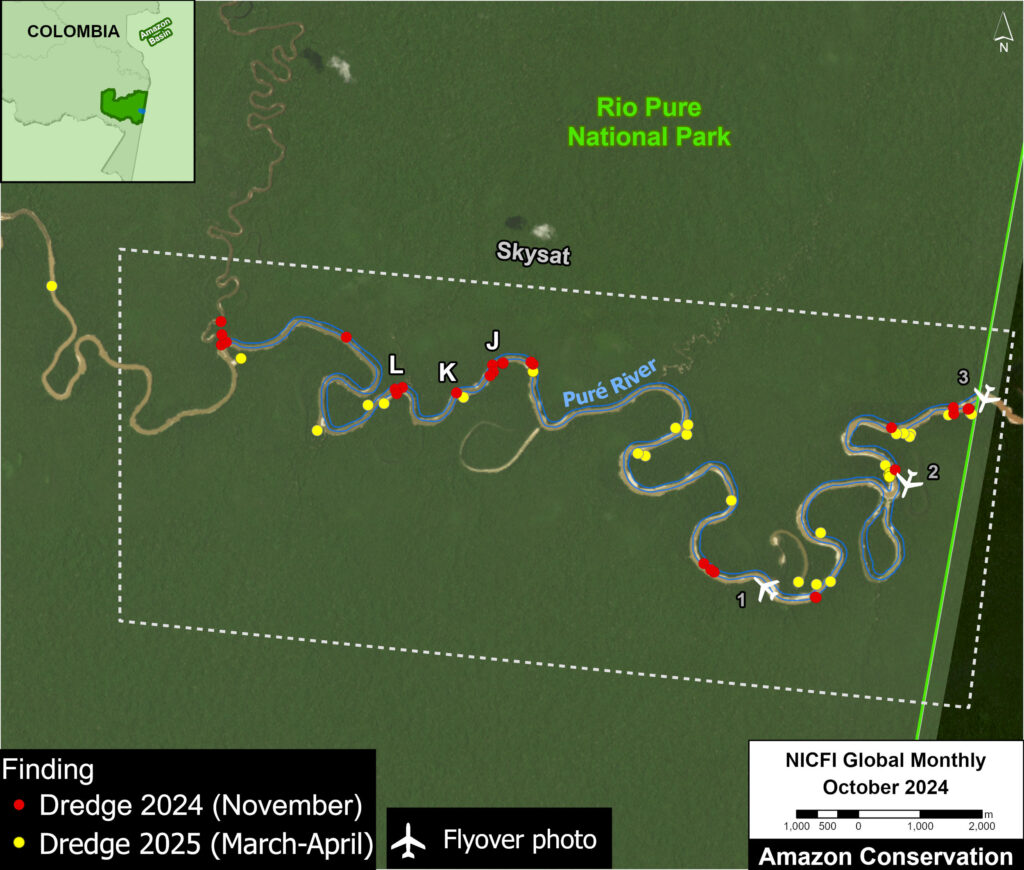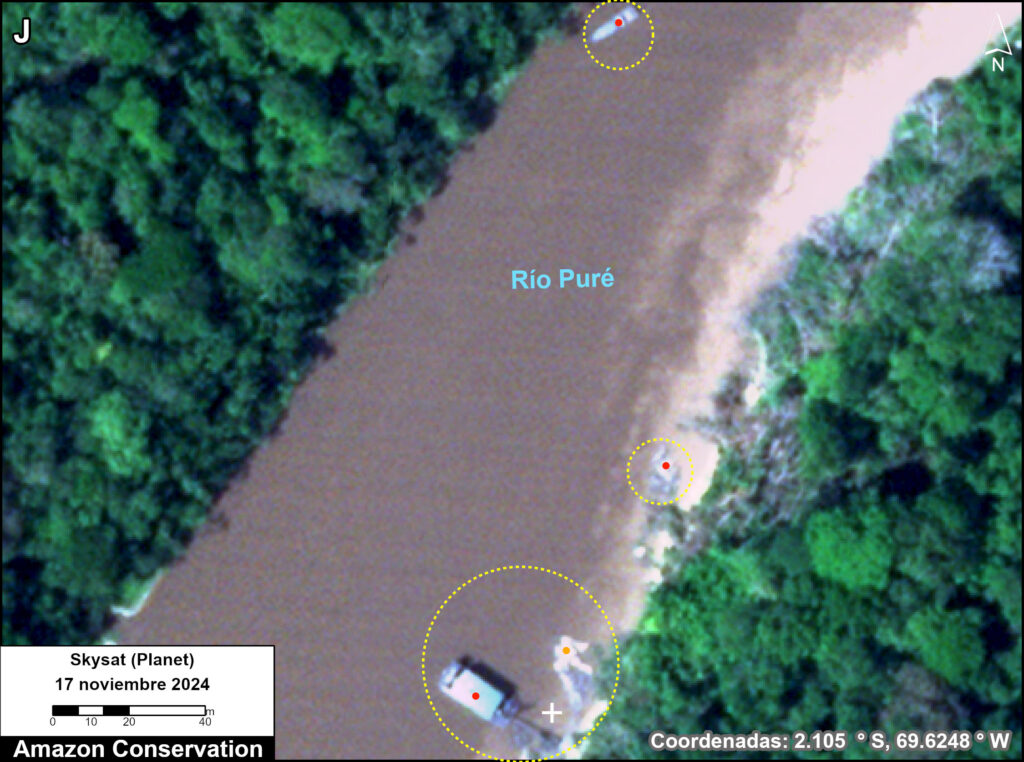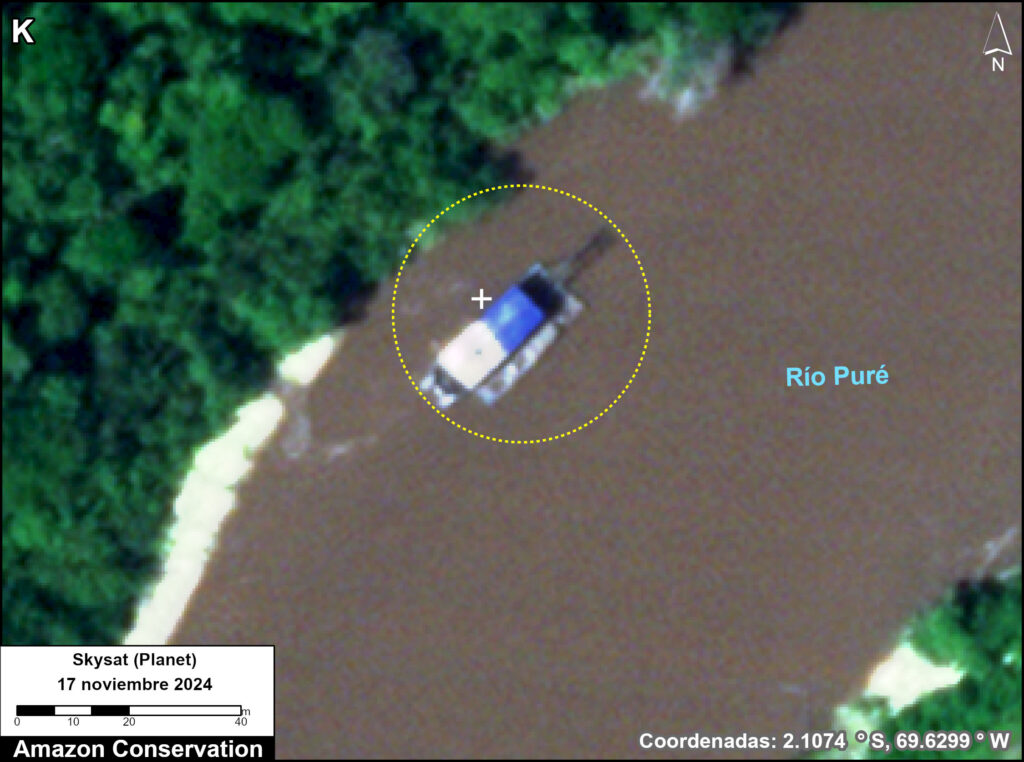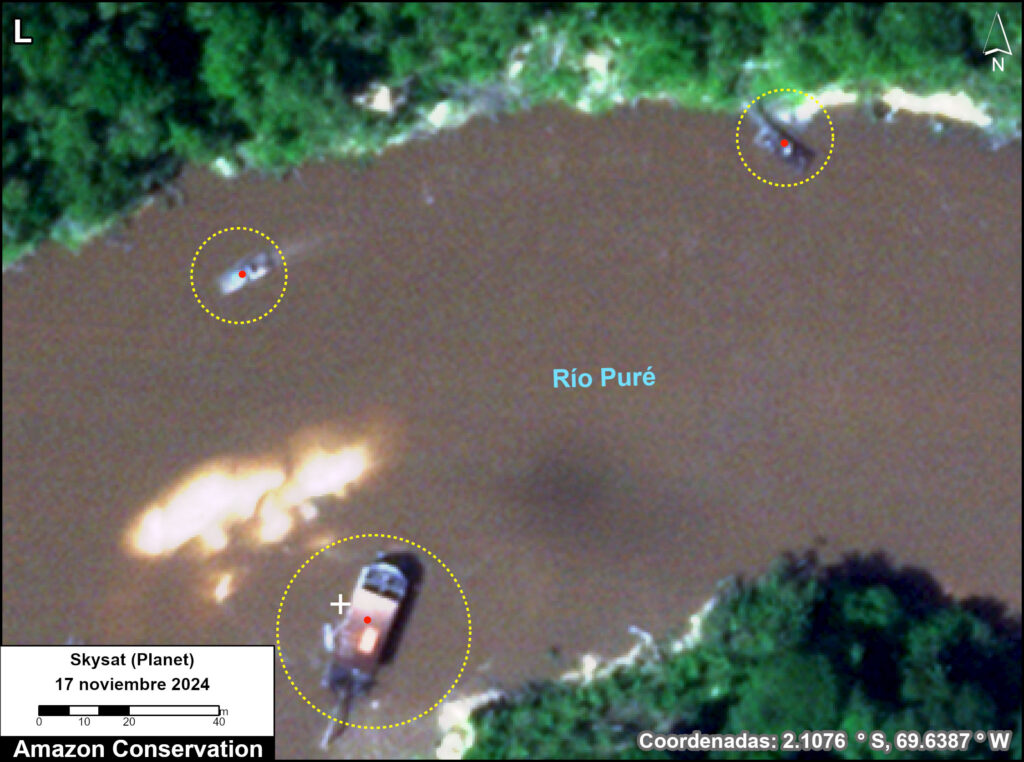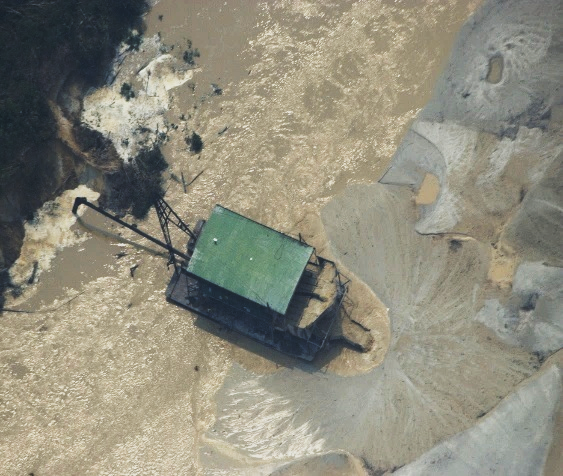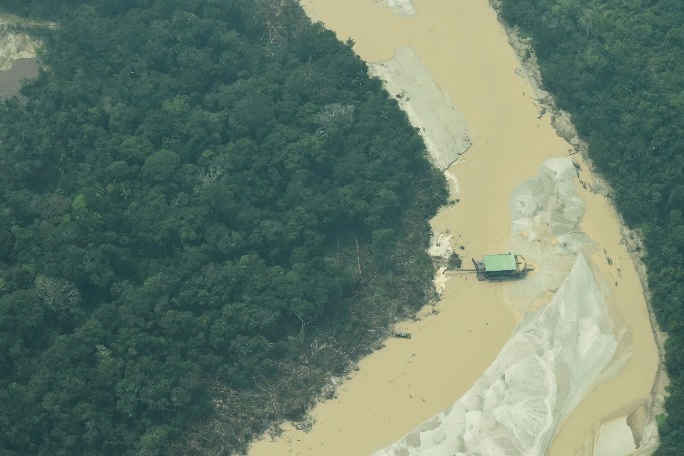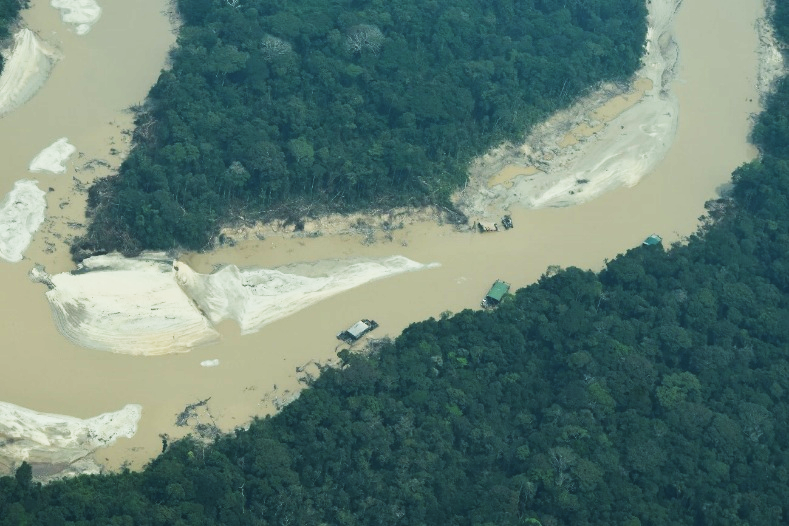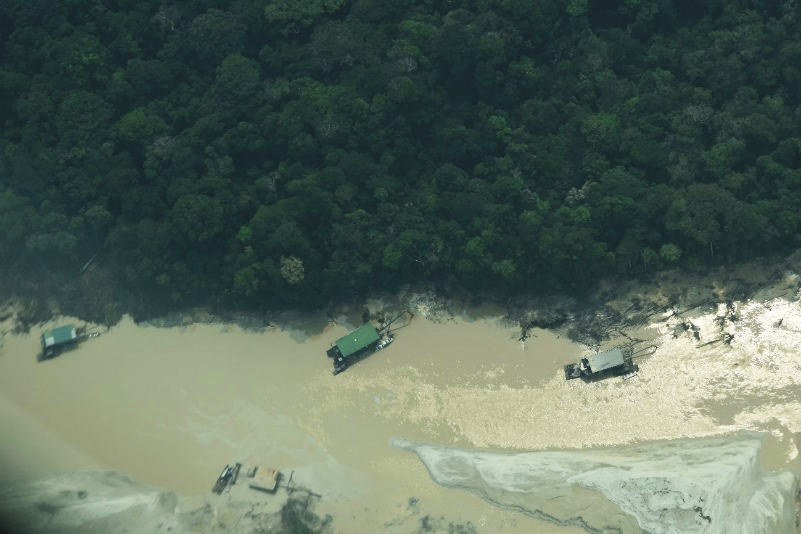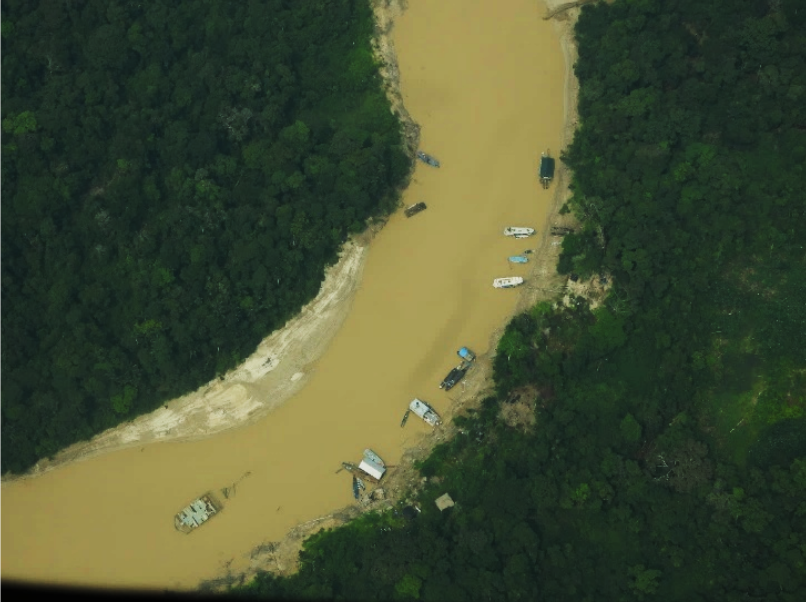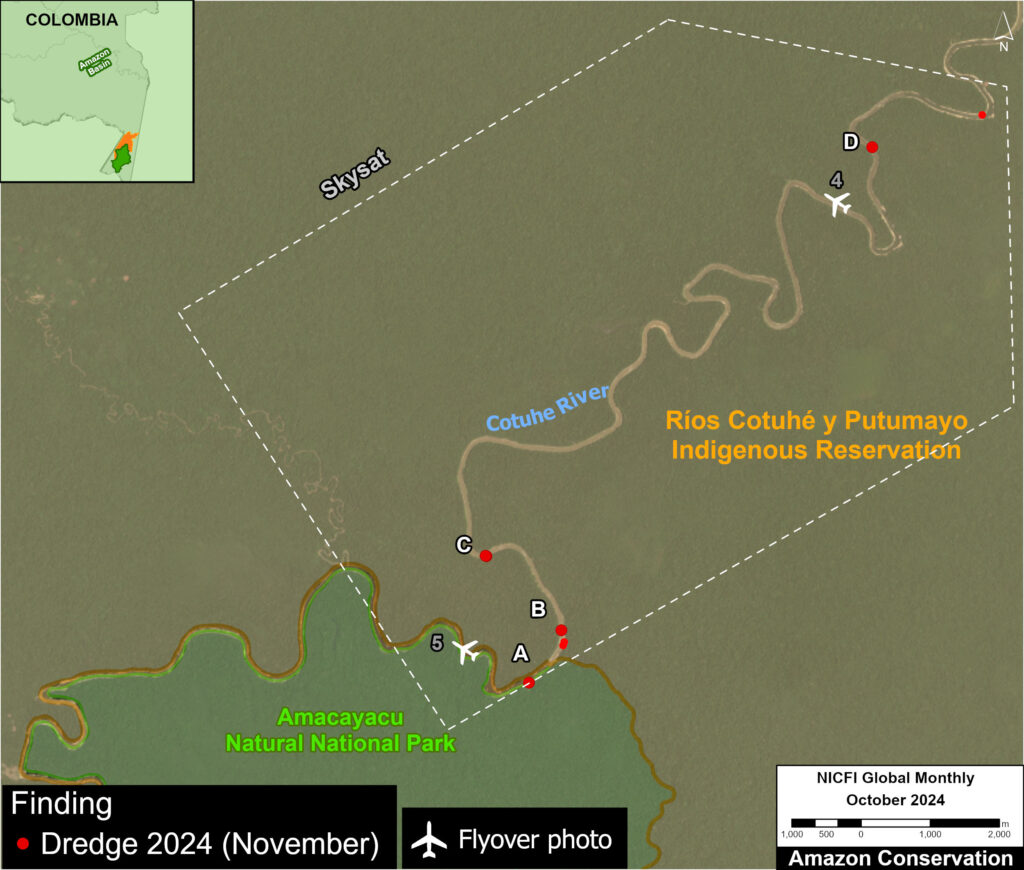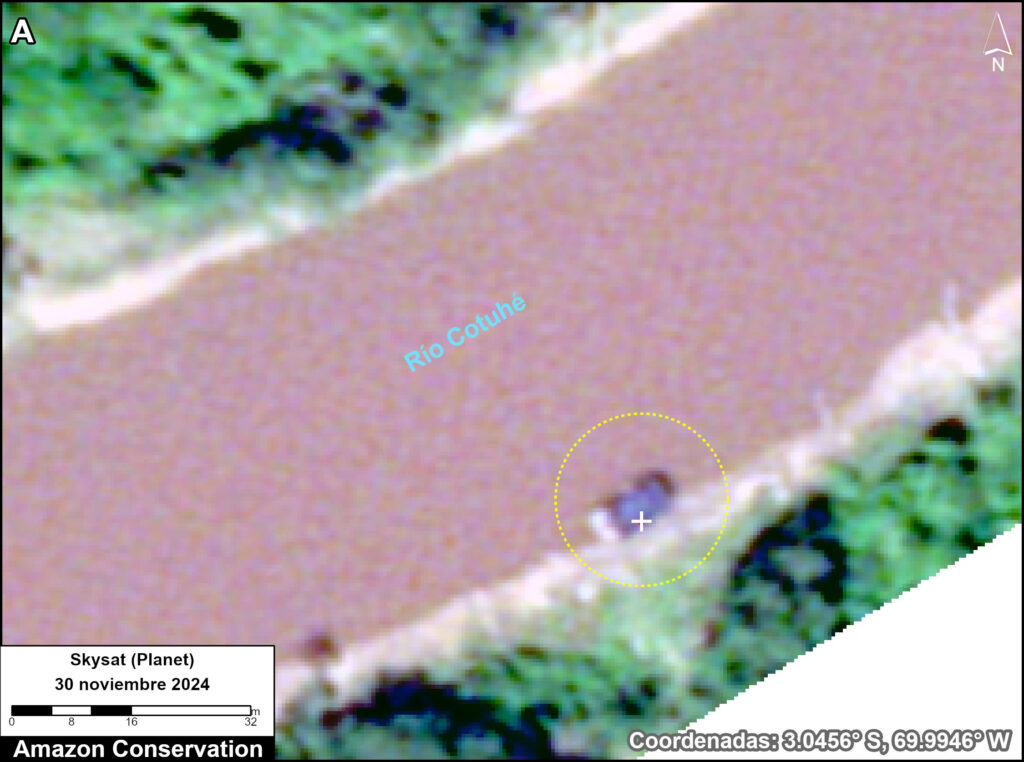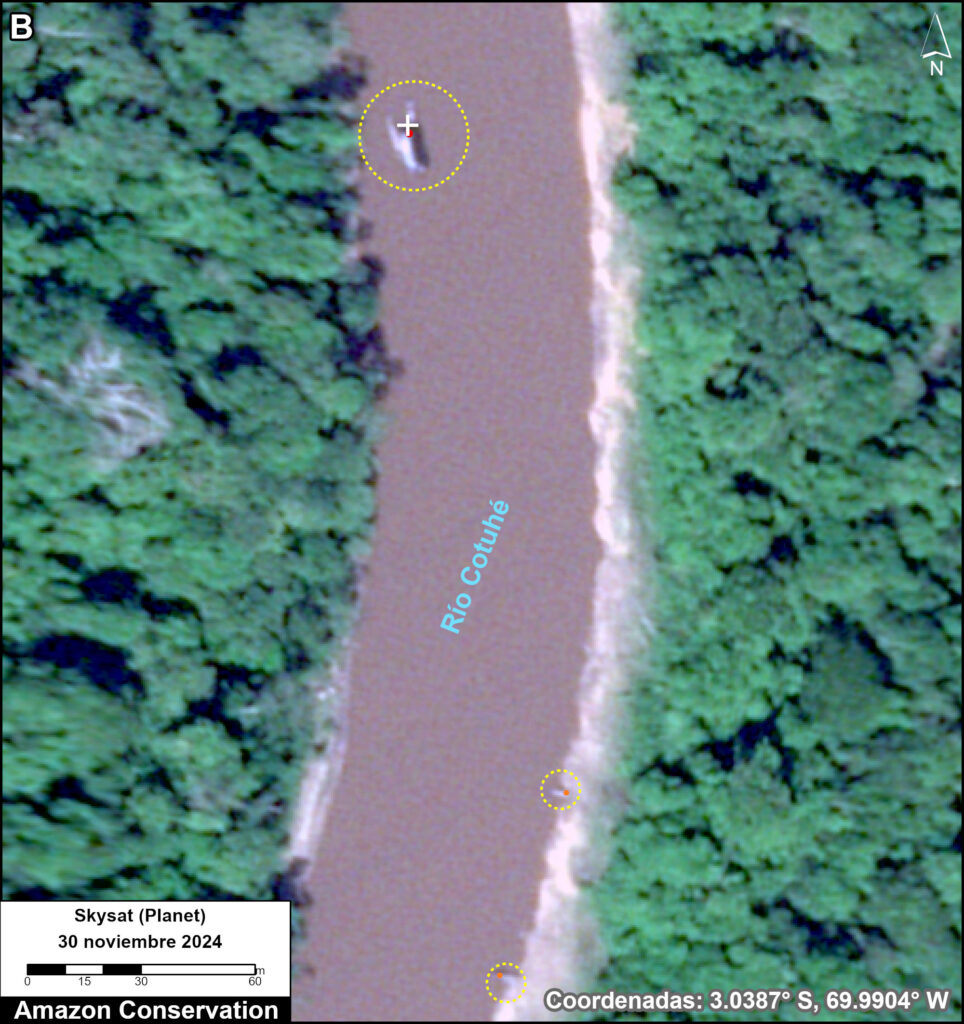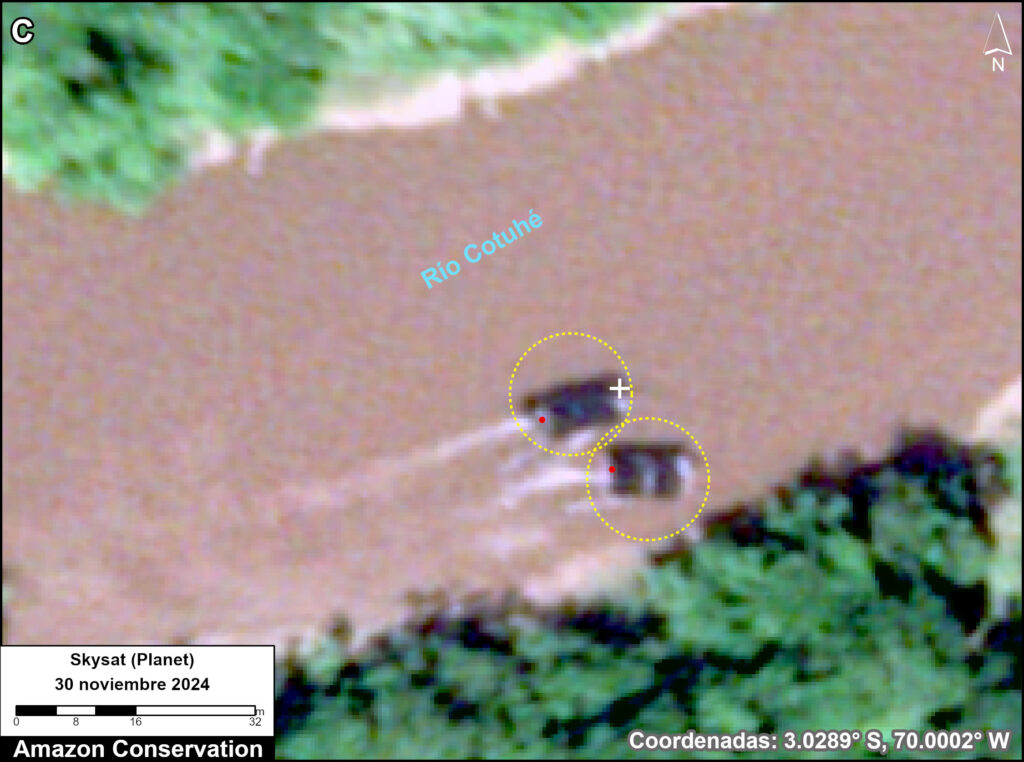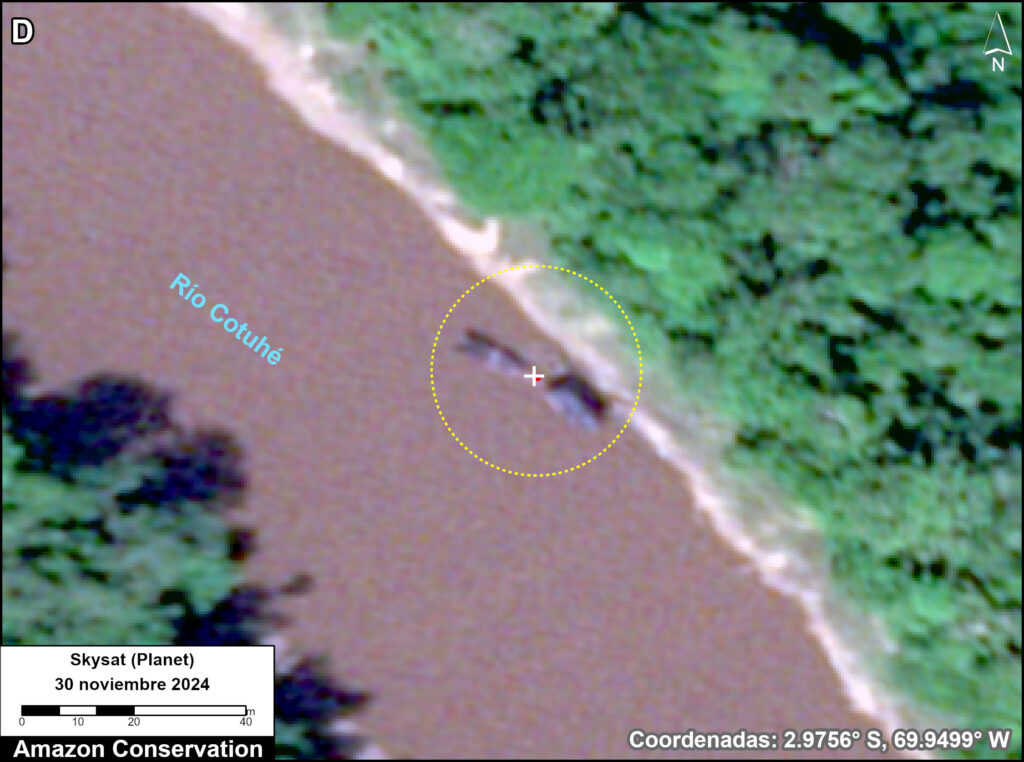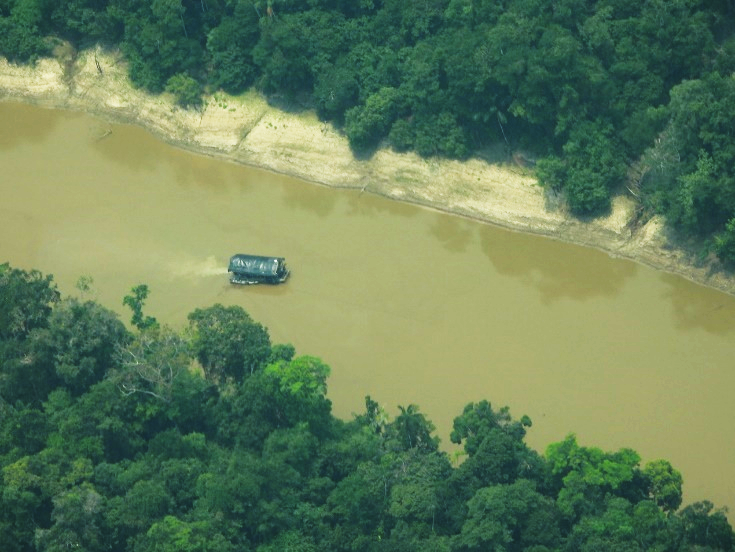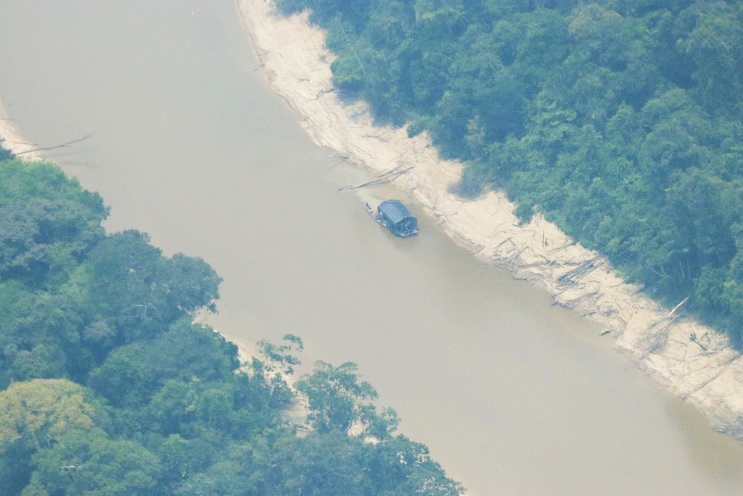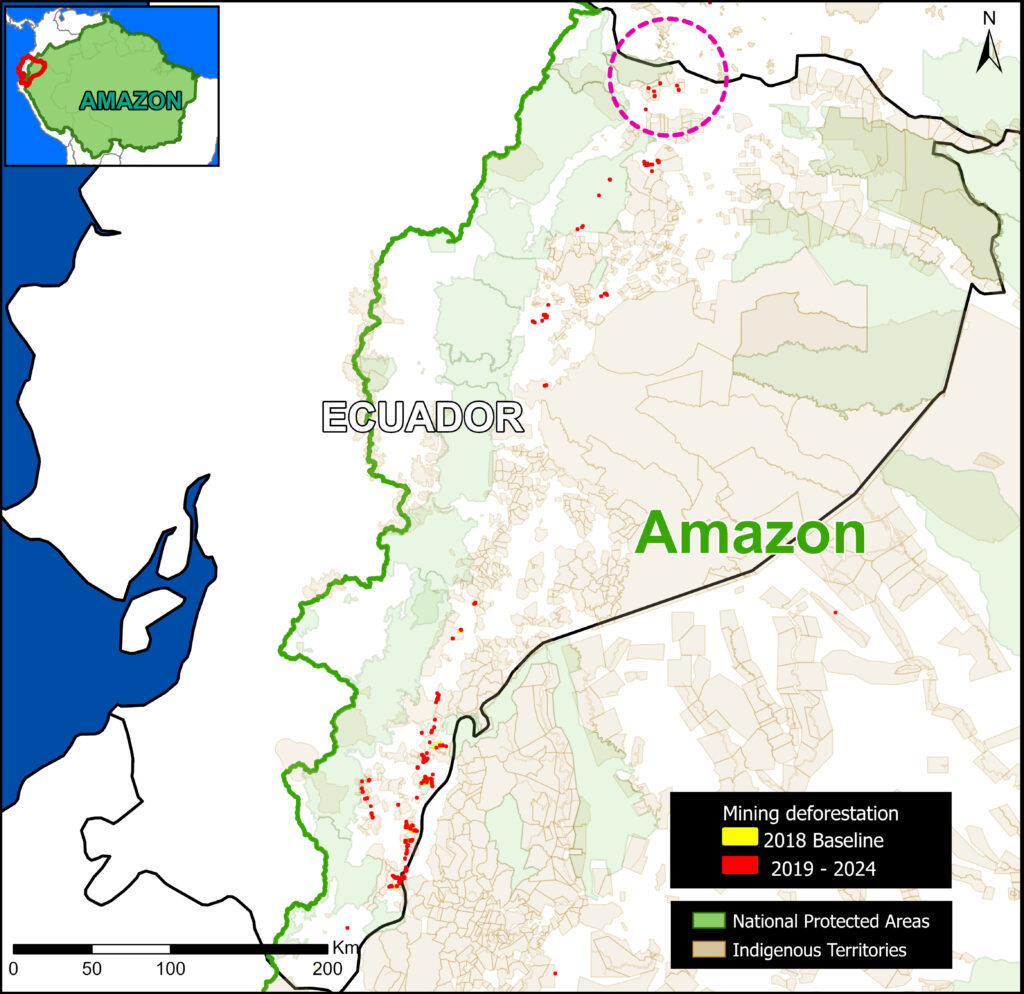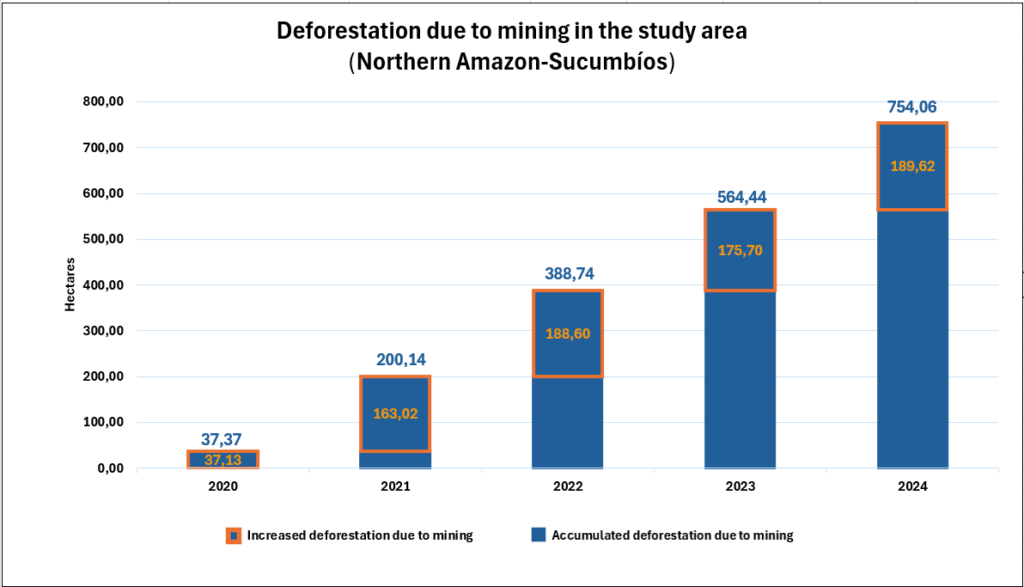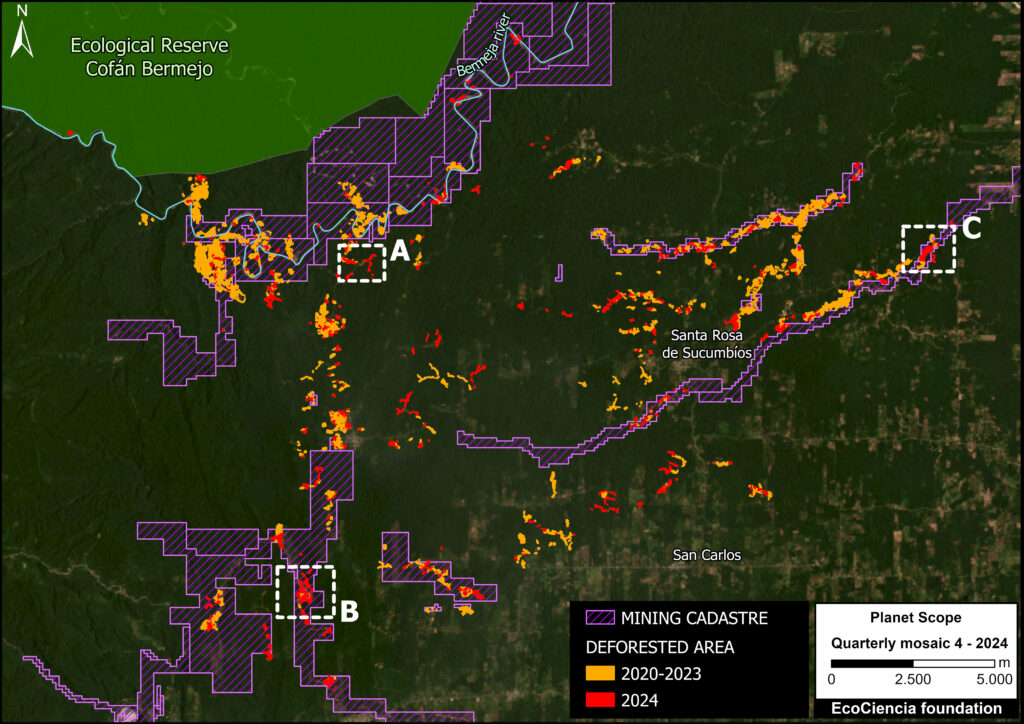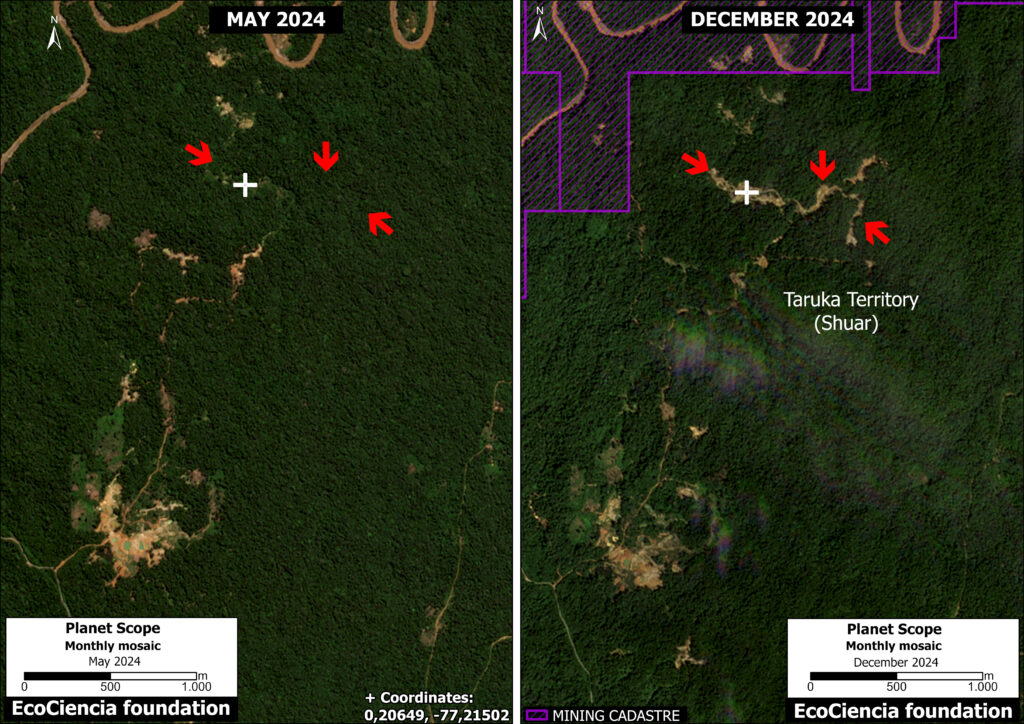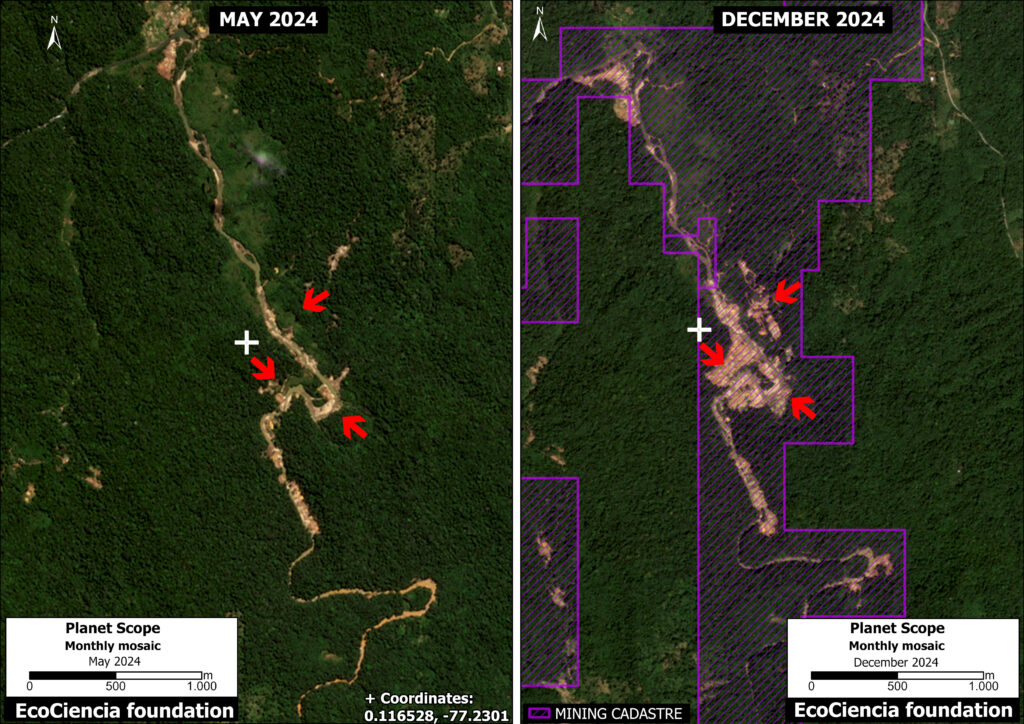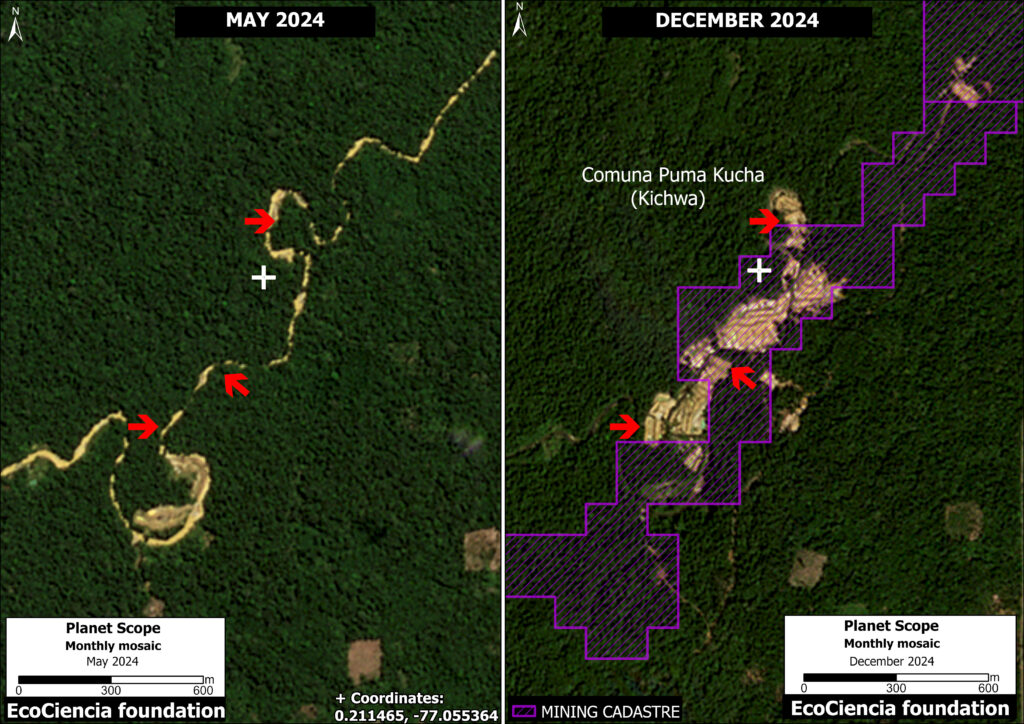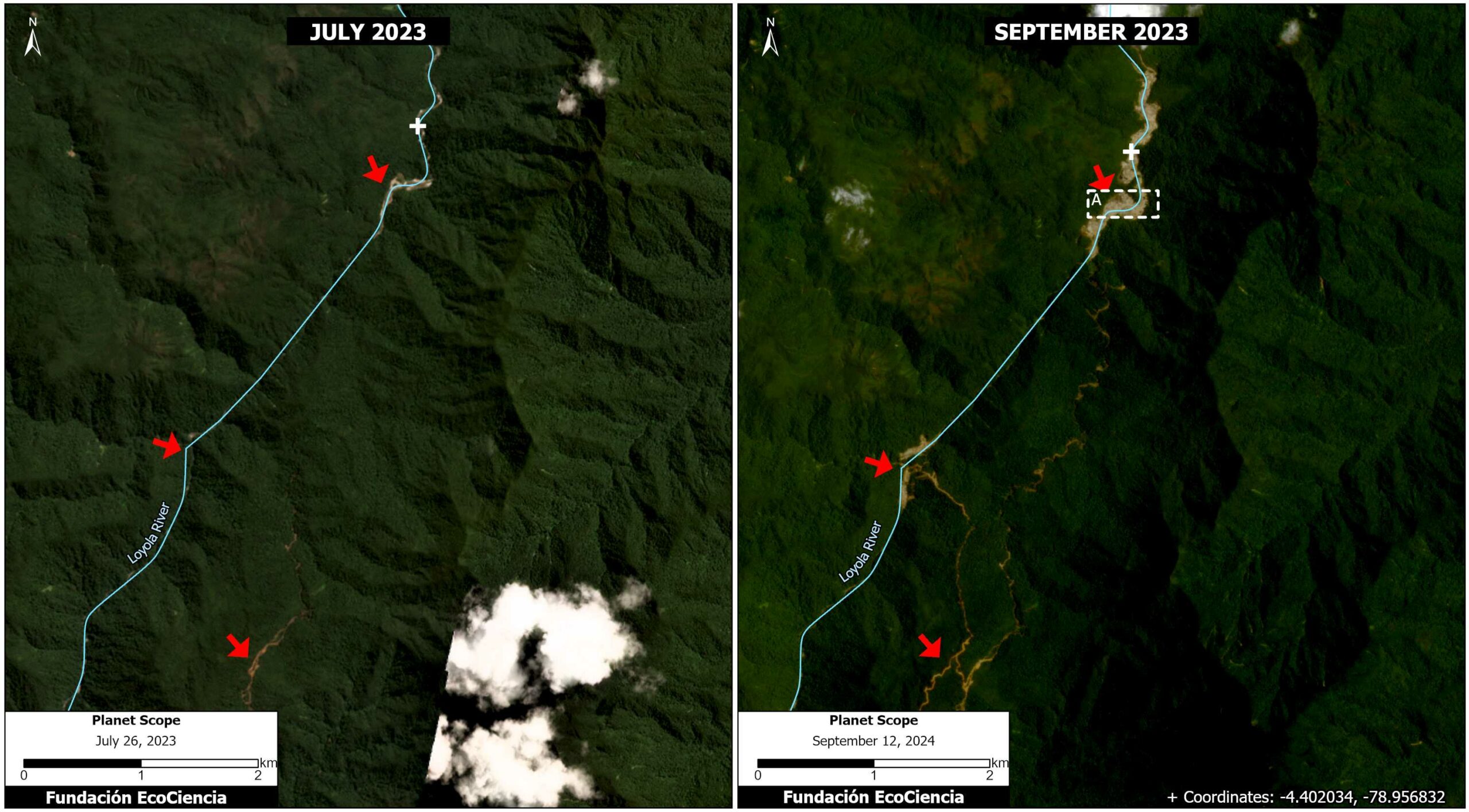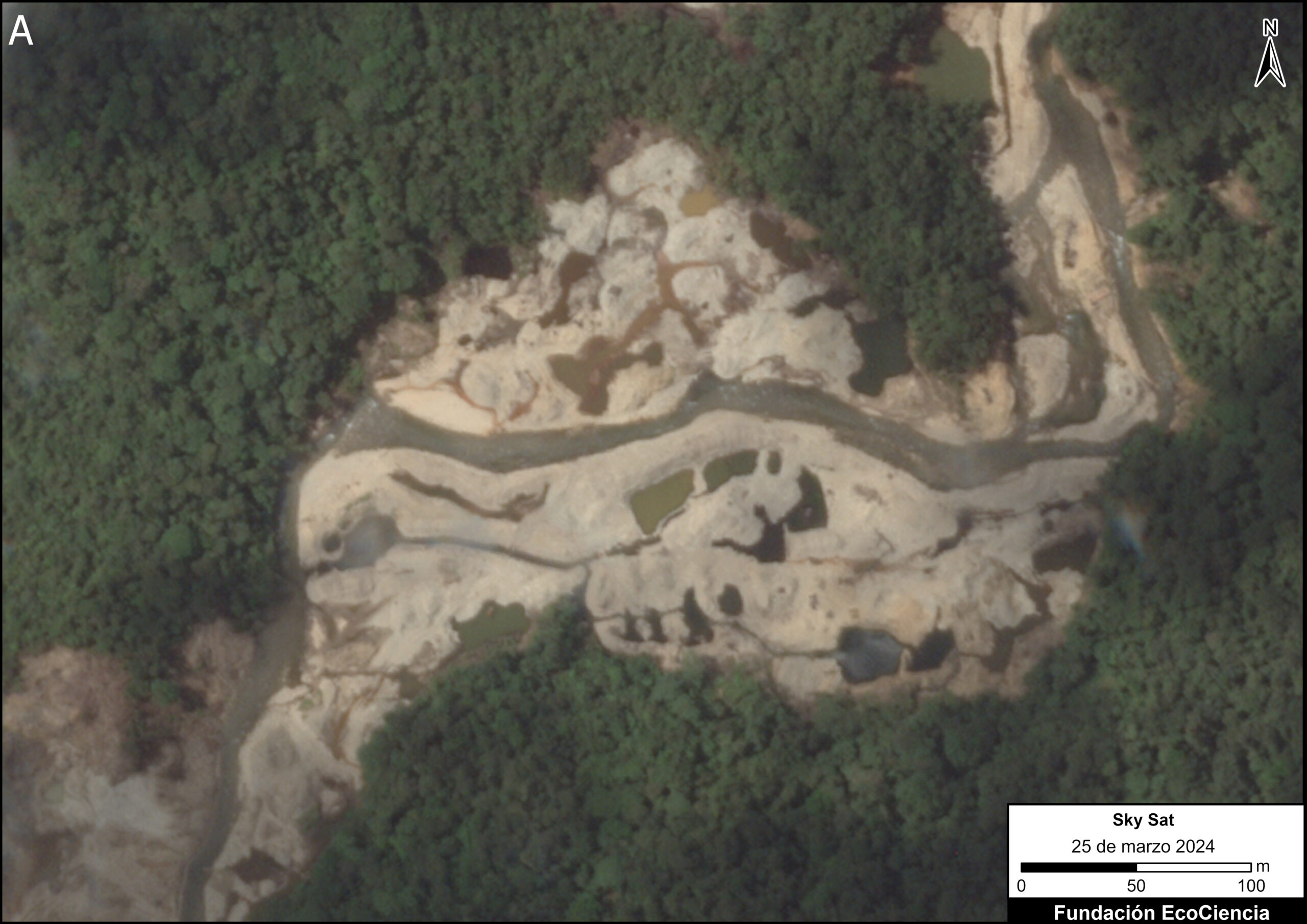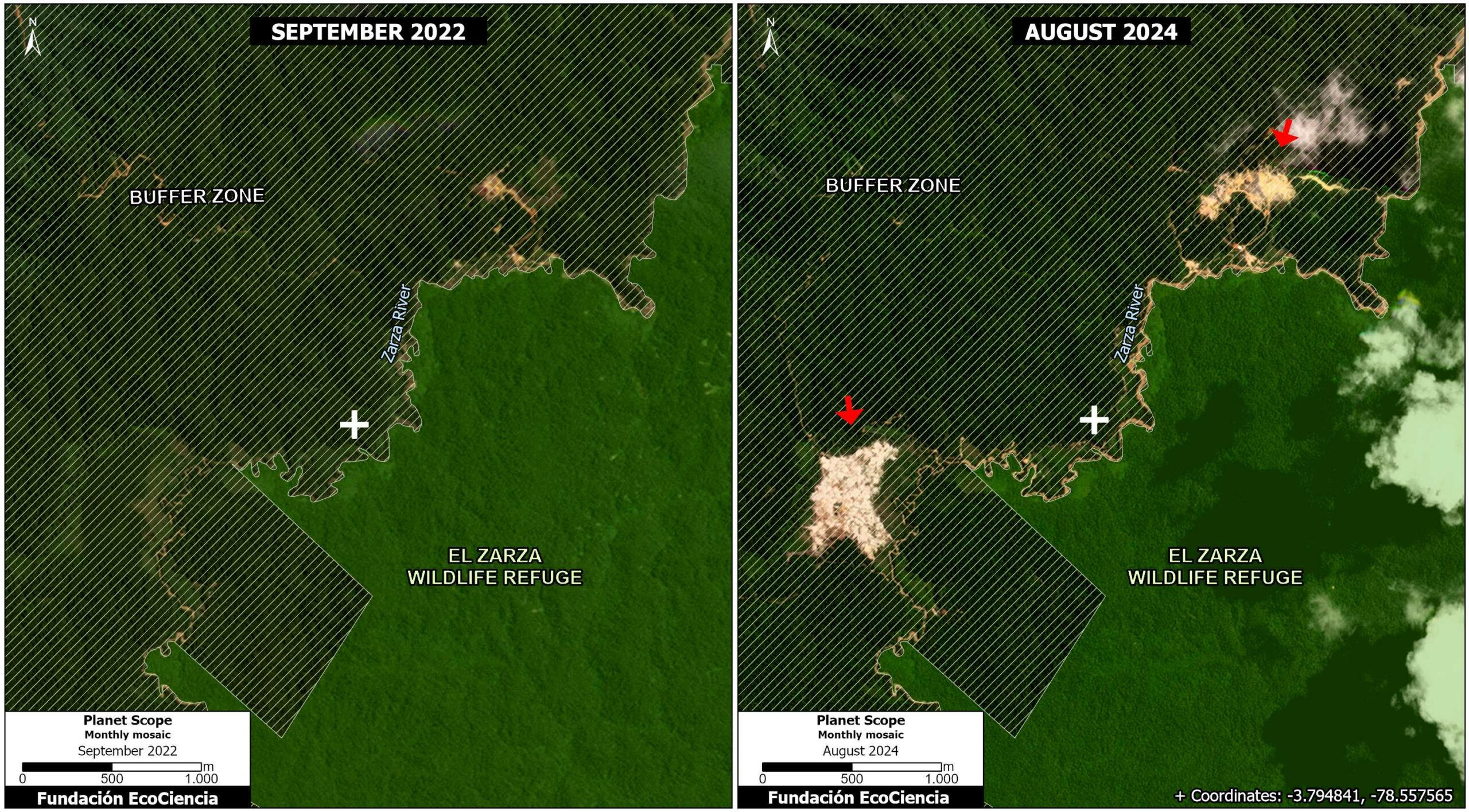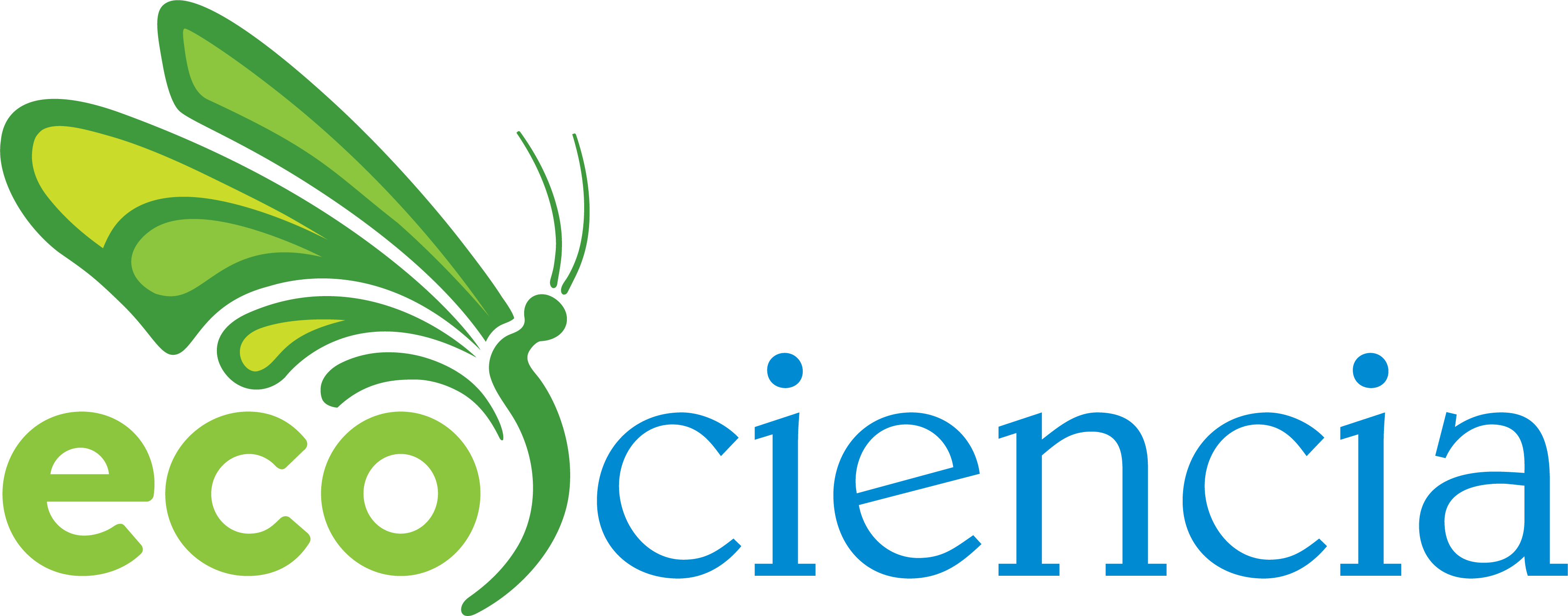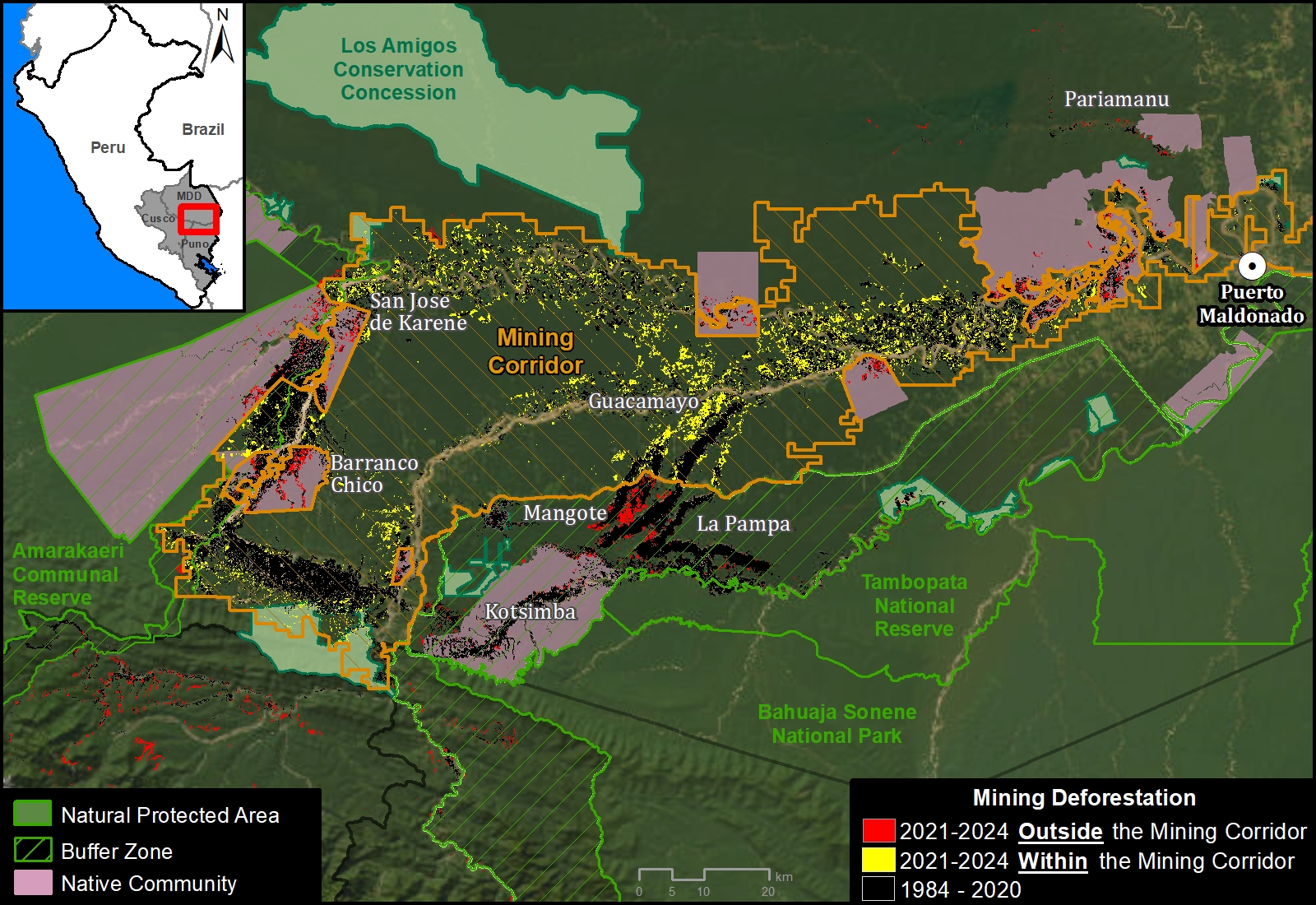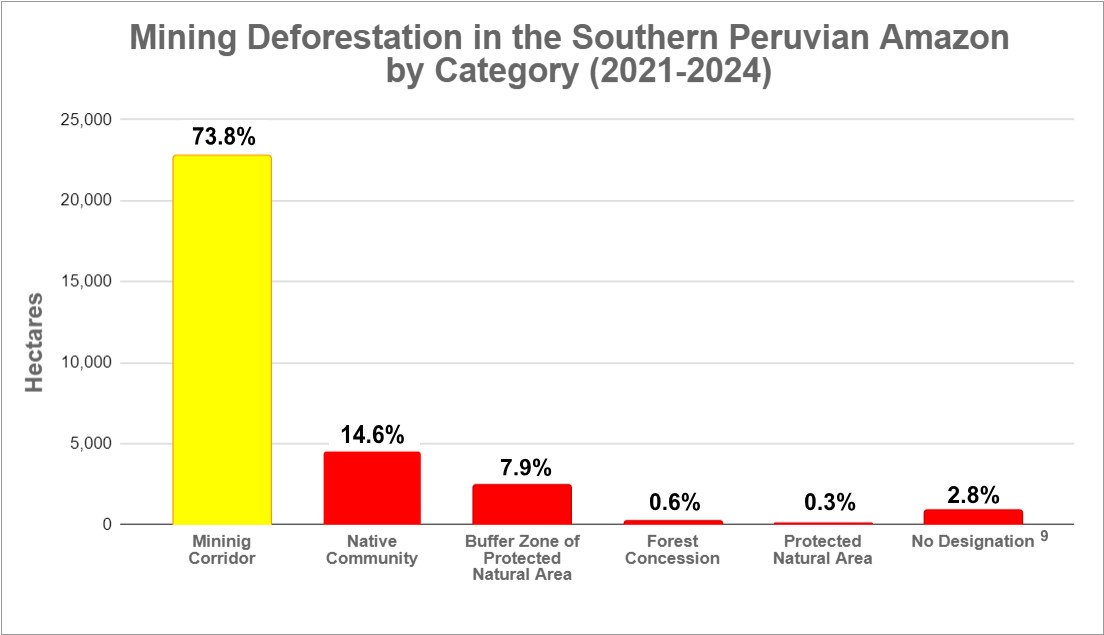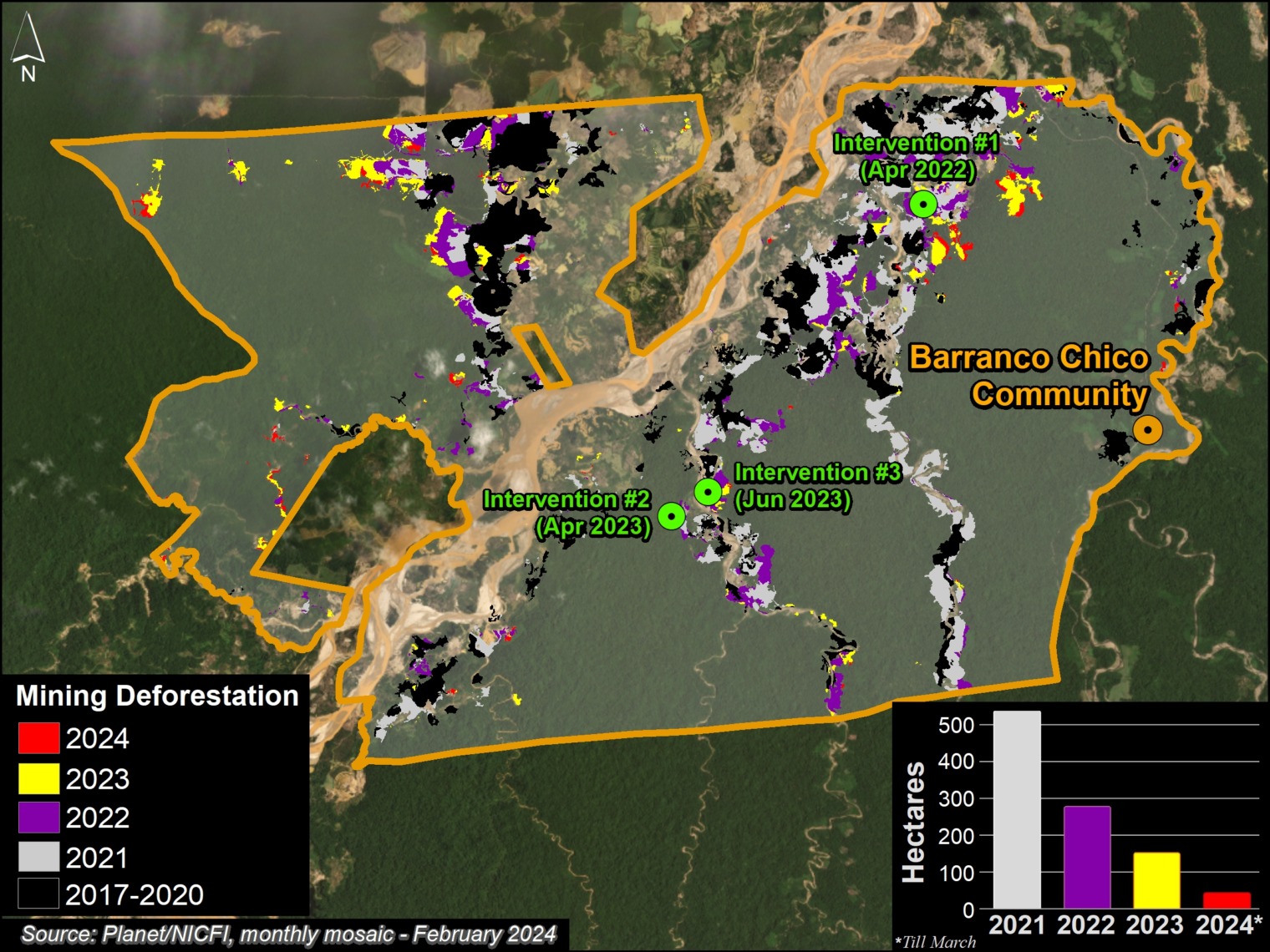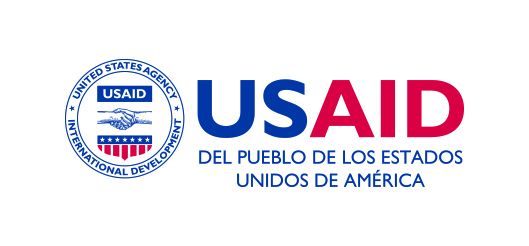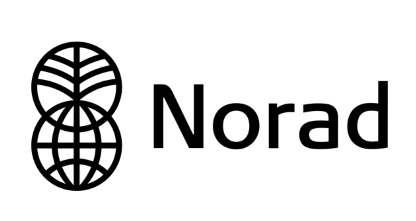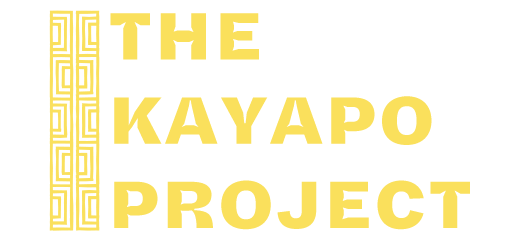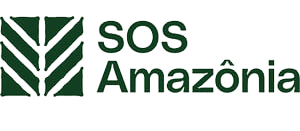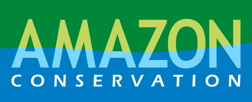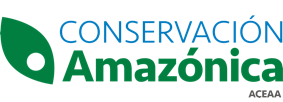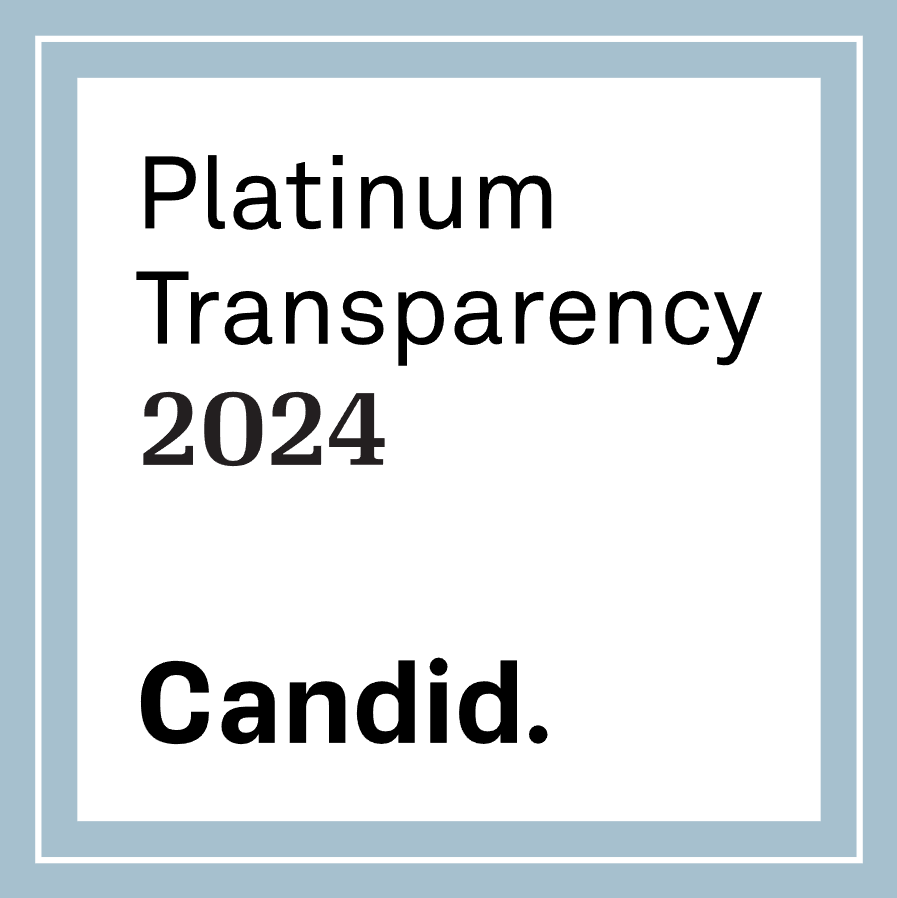
Gold mining continues to increase in the Peruvian Amazon. Following the initial success of the major multisectoral government intervention Operation Mercury in southern Peru in early 2019 (MAAP #104, MAAP #121, MAAP #130), the illegal mining activity rebounded during the COVID-19 pandemic, as the government withdrew from the area (Vadillo, 2022).
The current increase, directly linked to soaring international gold prices, has led to expanding mining activity: continuing mining in southern Peru, and emerging mining fronts in the central and northern parts of the country.
This report presents information on the current state of gold mining activity, in both forests and rivers, across all of the Peruvian Amazon.
Notably, we report that gold mining has spread to nine regions across the Peruvian Amazon: Amazonas, Cajamarca, Cusco, Huánuco, Loreto, Madre de Dios, Pasco, Puno, and Ucayali.
Total gold mining deforestation has reached 139,169 hectares (343,894 acres) as of mid-2025, the vast majority (97.5%) in the Madre de Dios region of southern Peru. The Huánuco and Puno regions have also experienced rising mining deforestation (1,262 and 1,014 hectares, respectively).
Moreover, alluvial gold mining is also expanding in numerous rivers across the Peruvian Amazon, especially in the northern regions of Loreto and Amazonas. We have identified 989 mining dredges in Loreto since 2017, followed by 174 in Amazonas.
Overall, we have documented gold mining activity in 225 water bodies (rivers and streams) across the Peruvian Amazon.
Below, we present the detailed results of this report in three regional sections: northern Peru (Amazonas, Cajamarca, and Loreto); central Peru (Huánuco, Pasco, and Ucayali); and southern Peru (Cusco, Madre de Dios, and Puno). Each section presents information about mining in forests (deforestation) and rivers.
Base Map. Data: ACA, ACCA, CINCIA, FEMA, SZF, IBC, SERNANP, Mapbiomas Perú
Northern Peru
Gold mining has spread to both the forests and rivers of Amazonas, Cajamarca, and Loreto regions of the northern Peruvian Amazon (Figure 1).
Gold mining deforestation has impacted 491 hectares, located near rivers and within Indigenous communities (see red areas in Figure 1). The mining deforestation has been localized along the Chinchipe River in Cajamarca, and near the Marañón River in Amazonas and Loreto.
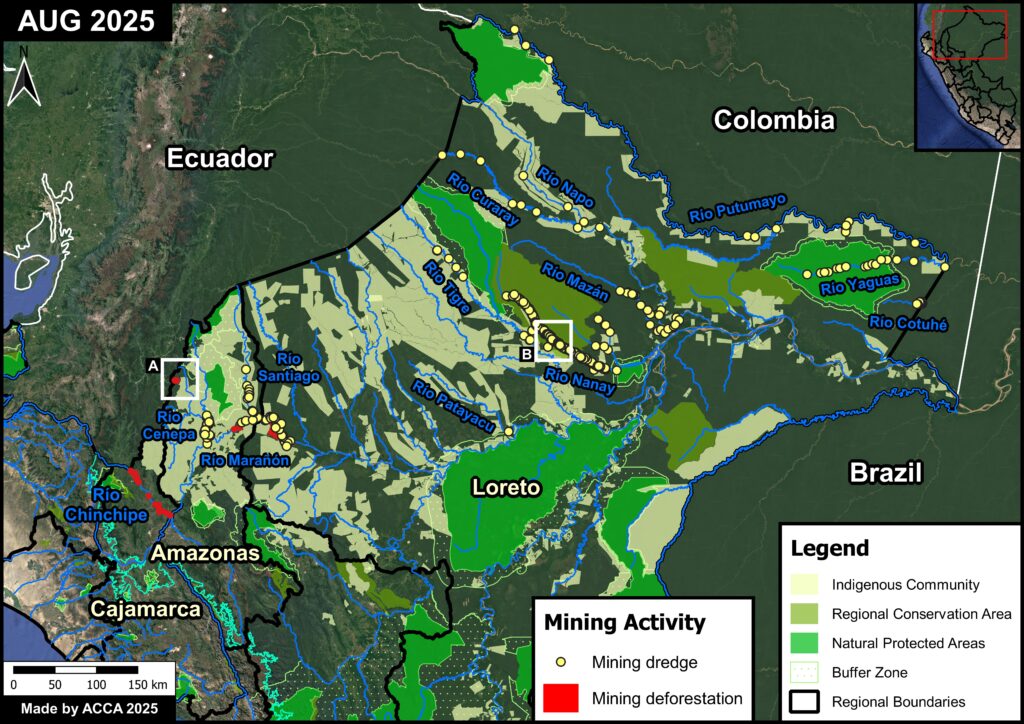
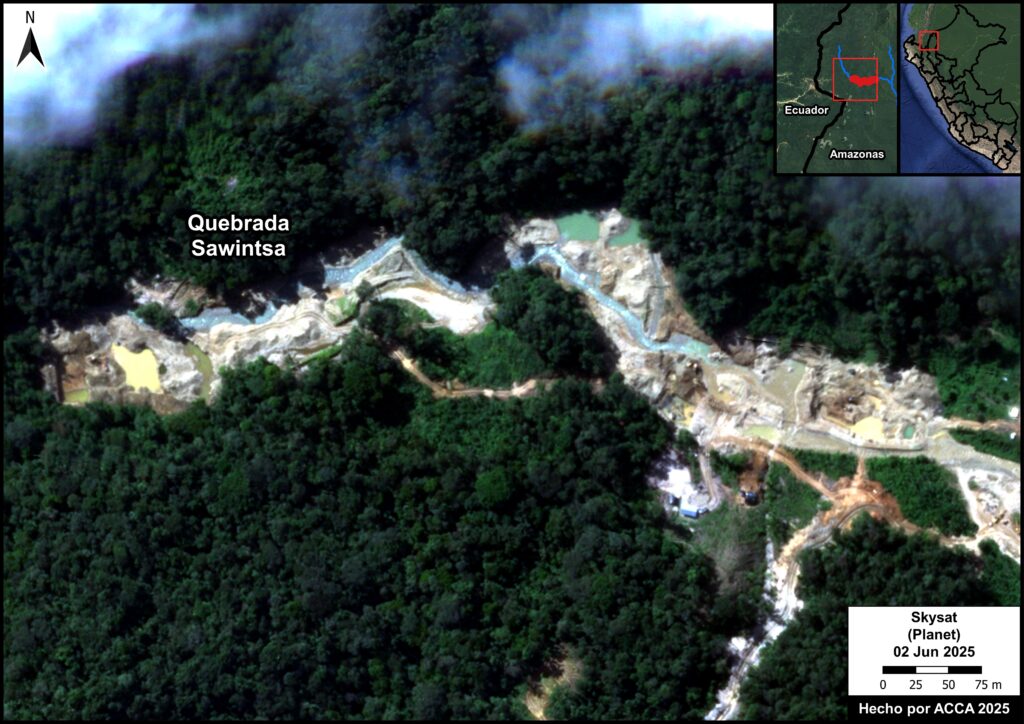
We highlight the recent mining deforestation along the Sawintsa River near the Peru-Ecuador border in the Amazonas and Cajamarca regions (Figura 1A).
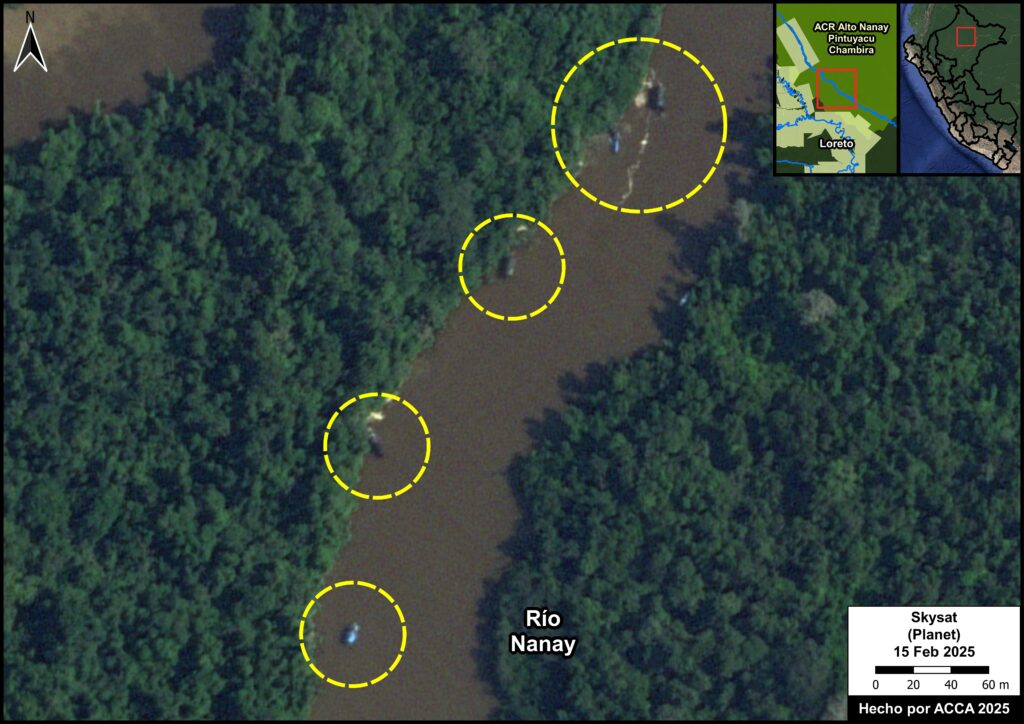
In addition, river-based mining has emerged as a critical issue in northern Peru, where we have documented mining barges in at least 14 rivers (see yellow dots in Figure 1).
Loreto is the most impacted region, where we have documented 989 mining dredges between 2017 and 2025.
The Nanay River, located in Loreto, is the most impacted by mining dredges Figure 1B. We have identified 841 mining dredges since 2017, including 275 in 2025. This mining activity extends into Indigenous communities and the Alto Nanay – Pintuyacu – Chambira Regional Conservation Area.
Mining also impacts the Cenepa and Santiago Rivers, located in Amazonas. We have identified 137 and 51 mining dredges, respectively, in these rivers since 2022. Some of this mining activity surrounds Indigenous communities in Amazonas.
Central Peru
Gold mining also impacts both the forests and rivers of Huánuco, Pasco and Ucayali regions in the central Peruvian Amazon (Figure 2).
Gold mining deforestation has reached 1,320 hectares, located along rivers, in Indigenous communities, in the Carpish Montane Forest Regional Conservation Area, and in the buffer zone of the El Sira Communal Reserve (see red areas in Figure 2).

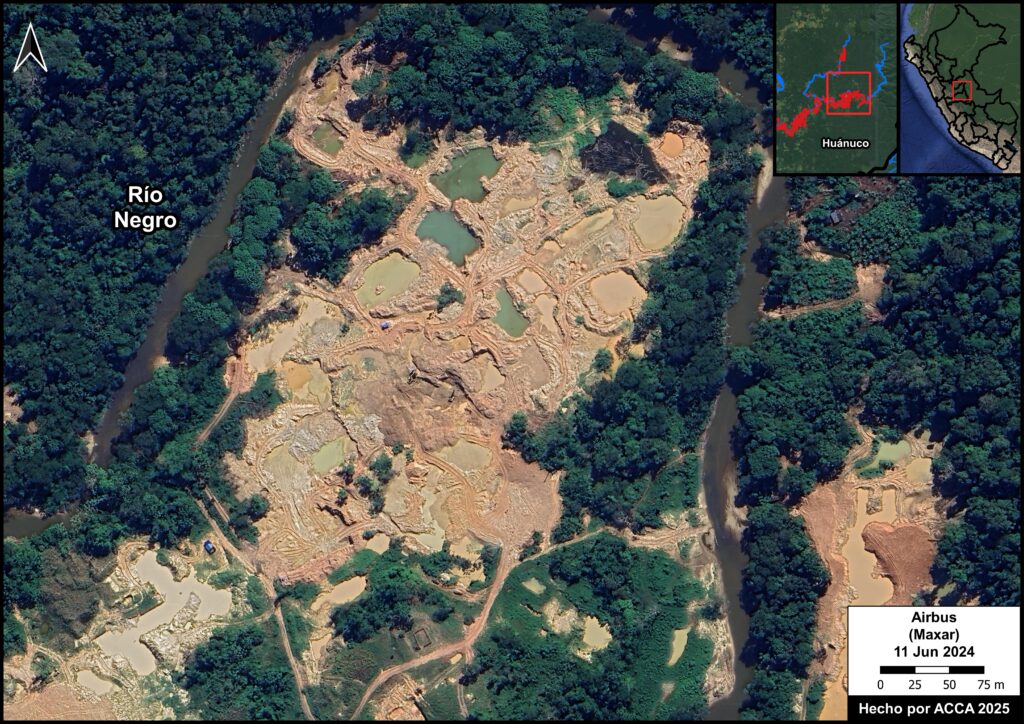
The Huánuco region is the most impacted by mining deforestation in central Peru, with the vast majority (97%) occurring in the province of Puerto Inca (Figure 2A).
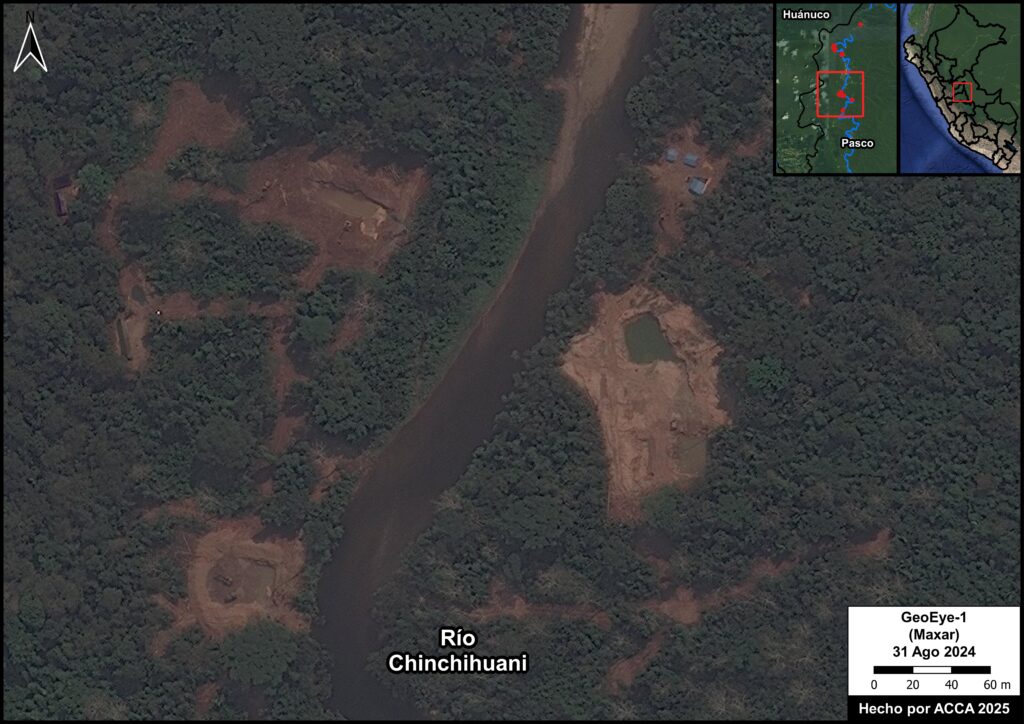
In the Pasco region, gold mining deforestation has been recorded in pending mining concessions along the Chinchihuani River since August 2024 (Figure 2B).
Gold mining in the Ucayali region has been located along the Abujao River.
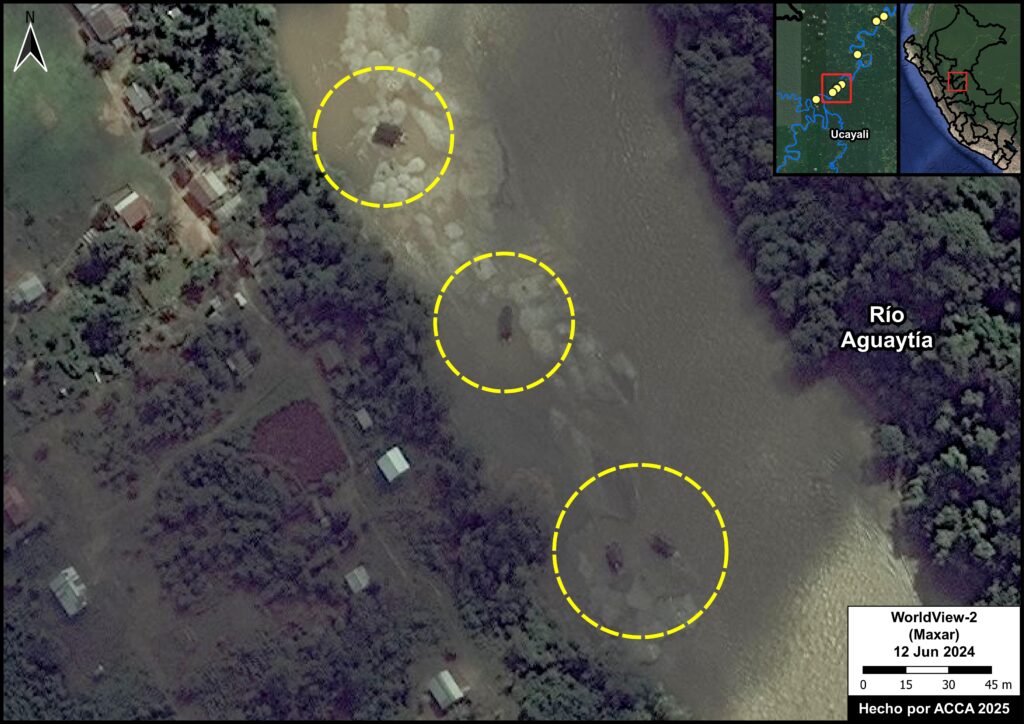
In addition, river-based mining is impacting the Aguaytía River, in the Ucayali region (see yellow dots in Figure 2).
We first detected mining dredges in mid-2024 (Figure 2C) in this area, located near the buffer zone of Cordillera Azul National Park.
In total, we have identified 26 mining dredges in the Aguaytía River in 2024 and 2025.
Southern Peru
Gold mining deforestation has had major impacts in the regions of Cusco, Madre de Dios, and Puno, in the southern Peruvian Amazon. Note in Figure 3 that mining deforestation (indicated in red) is the dominant impact, and not mining barges as seen in the northern Peruvian Amazon.
We have documented the gold mining deforestation of 137,558 hectares (339,913 acres) in these southern regions, accounting for 98.7% of total mining deforestation in the Peruvian Amazon. This massive gold mining deforestation started in 1984 in Madre de Dios.
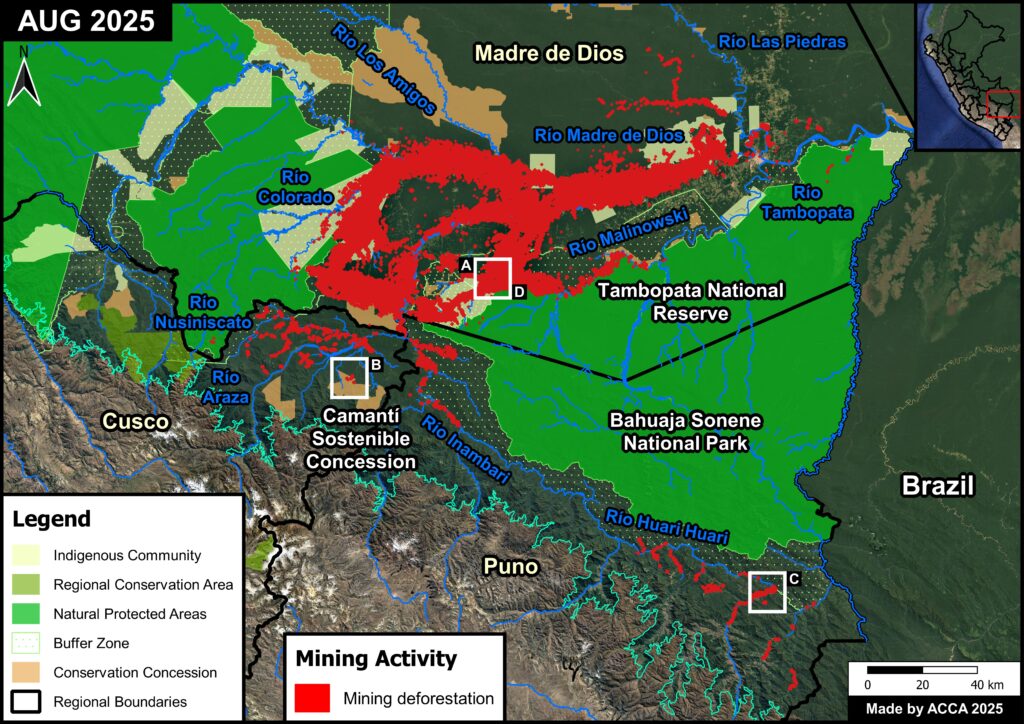

Madre de Dios has the highest gold mining deforestation of all the regions in Peru (135,939 hectares), accounting for 97.5% of the national total.
This widespread mining deforestation in Madre de Dios has extended into Indigenous communities and the buffer zones of protected areas, such as Tambopata National Reserve (Figure 3A) and Amarakaeri Communal Reserve.
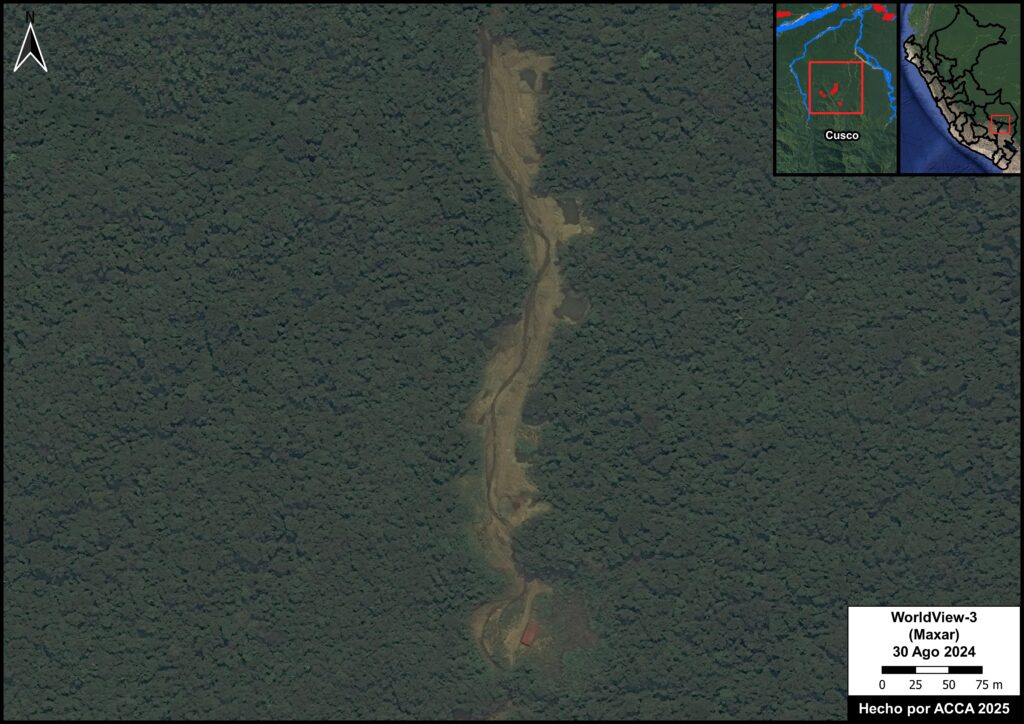
In the Cusco region, gold mining deforestation has spread to various areas around the Araza and Nusiniscato Rivers.
Además, parte de la deforestación por minería se ha extendido al interior de la zona de amortiguamiento de la Reserva Comunal Amarakaeri y en la Concesión para Conservación Camanti Sostenible (Figura 3b).
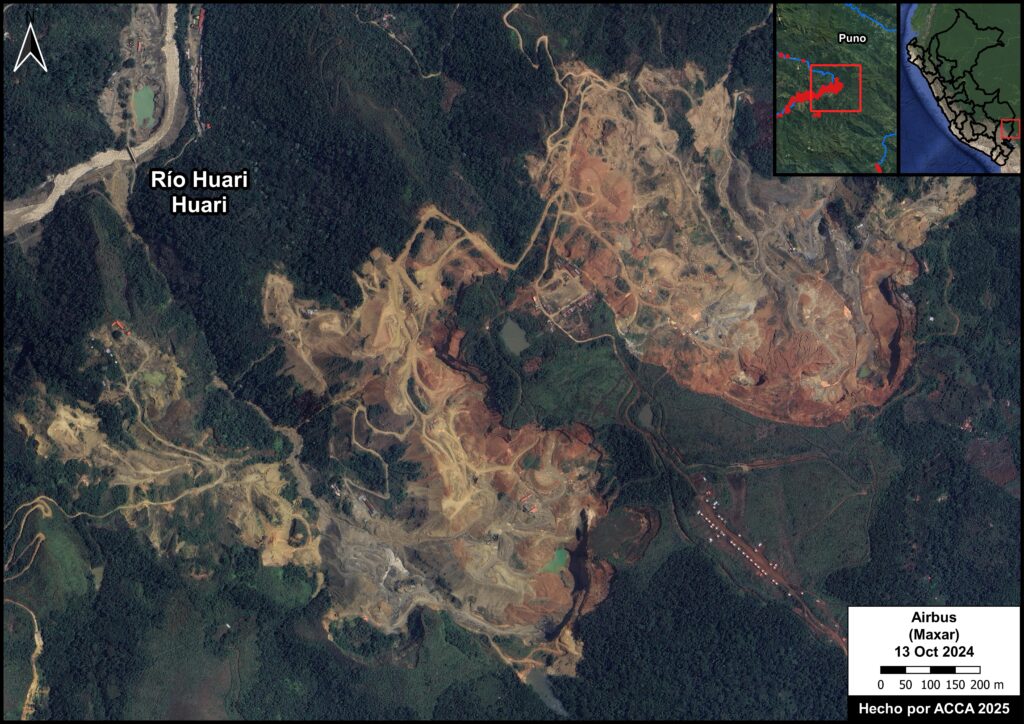
The Puno region has experienced gold mining deforestation near the Inambari and Huari Huari Rivers (Figure 3C), surrounding the buffer zone of the Bahuaja Sonene National Park.
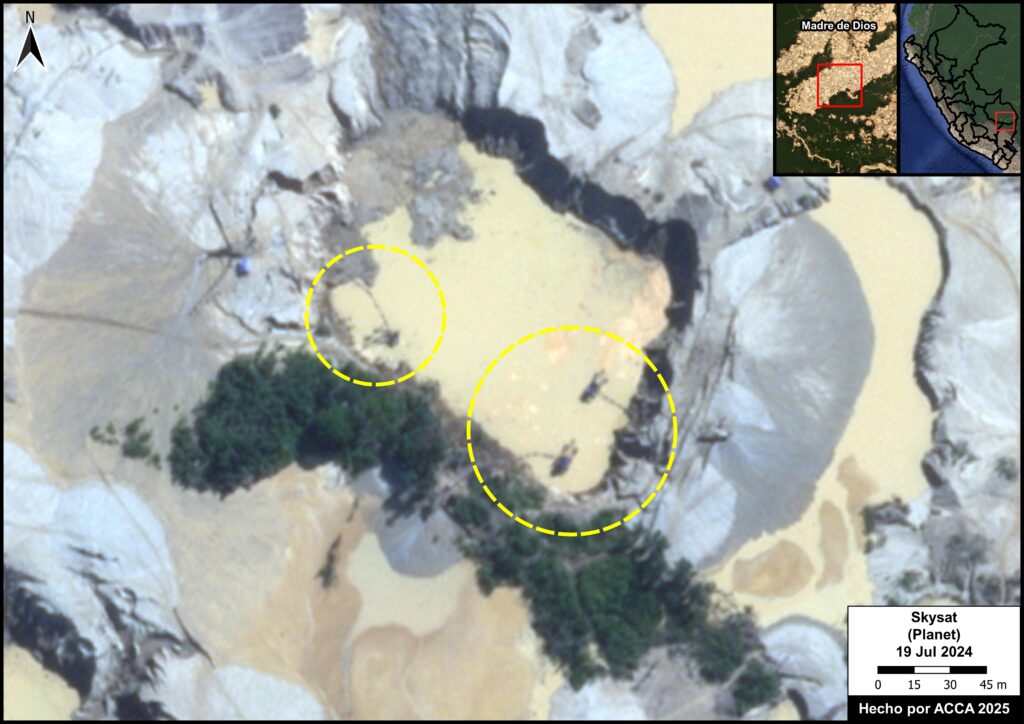
In Madre de Dios, we have detected over 2,000 pieces of mining infrastructure, such as drills, chutes, dredges, and mining rafts (Figure 3D) (ACCA, 2022).
Policy recommendations for gold mining in Peru:
Gold mining in Peru represents one of the country’s greatest socio-environmental challenges, impacting Amazonian forests, rivers, and local communities (Arana Cardó, M, 2024). In response, we present five policy proposals aimed at minimizing this impact, focusing on 1) implementing gold traceability, 2) strengthening the Artisanal and Small-scale mining (ASM) Law, 3) establishing environmental obligations, 4) strengthening supervision, and 5) promoting clean technologies (including banning mercury).
1. Implement an effective gold traceability system that links production, marketing, and export
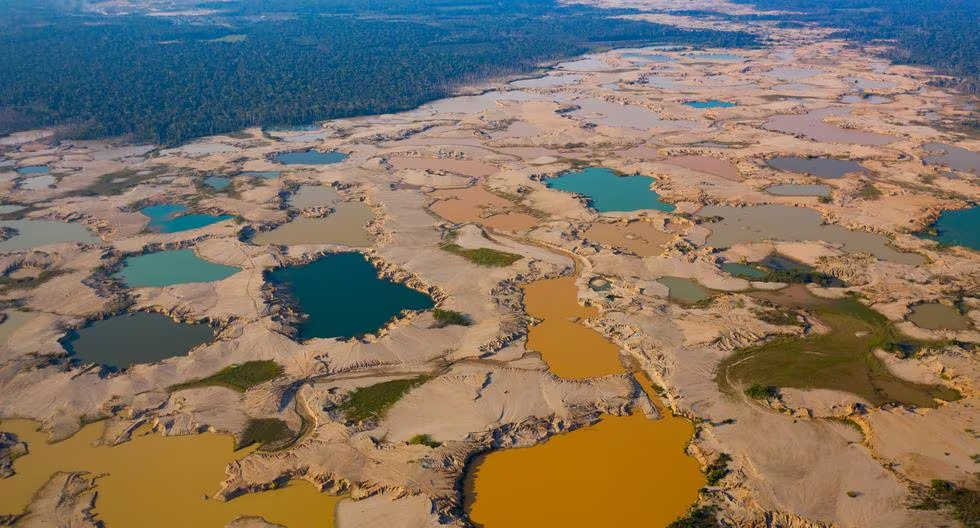
Currently, the Special Registry of Gold Traders and Processors, created by Ministerial Resolution No. 249-2012-MEM-DM, lacks effective mechanisms for cross-referencing information.
Therefore, it is recommended to consolidate a comprehensive traceability system that covers not only producers, traders, processors, and exporters, including the jewelry industry, but also the control of critical inputs such as mercury and fuels, in order to guarantee supply chains free of contamination and illegal activities.
This system must integrate real-time digital controls, cross-reference information between what is declared as production and what is actually traded, prevent the illegal export of gold in the form of jewelry, and align with international due diligence requirements.
2. Strengthening the Artisanal and Small-scale mining (ASM) Law & improving the formalizatin registry (REINFO)
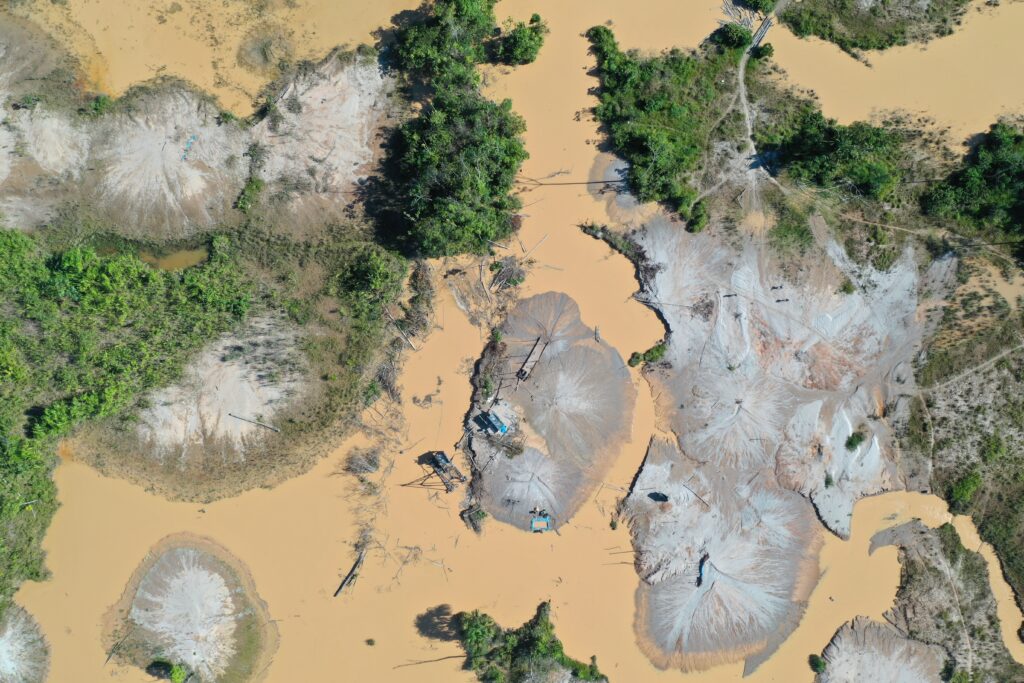
Regulations on small-scale and artisanal mining should establish clear categories based on production and technology, differentiating the formalization process (aimed at pre-existing informal miners and includes phased-in measures and technical support) from the ordinary permitting process, which requires full compliance with environmental and technical requirements for new projects.
The new law for Artisanal and Small-scale mining (ASM) should incorporate real incentives for formalization and the adoption of sustainable practices, effective oversight mechanisms, and the delimitation of exclusive zones for formalized activity, excluding natural Protected Areas, Indigenous reserves, bodies of water, and cultural heritage sites.
Additionally, this new regulation must establish mandatory due diligence throughout the gold value chain, linking the formalization process to the implementation of a traceability system. Thus, formalized miners must not only comply with basic legal requirements but also ensure that their production is free of illegal inputs such as mercury, meeting international standards of transparency and sustainability.
Likewise, given the formalization extension granted until December 31, 2025, in Supreme Decree No. 012-2025-EM, it is essential that the government improve the Comprehensive Registry of Mining Formalization (REINFO in Spanish), permanently removing those who do not meet the minimum requirements established in Law No. 32213 and its regulations, as indicated by its update through Supreme Decree No. 009-2025-EM. Furthermore, proportional sanctioning mechanisms must be evaluated to discourage the misuse of the registry. Only in this way will it be possible to prevent this registry from continuing to be used as a shield of impunity against the actions of the Public Prosecutor’s Office and the National Police, and to ensure that formalization translates into an effective change in mining practices.
3. Establish environmental obligations from the beginning of mining formalization & ensure their supervision
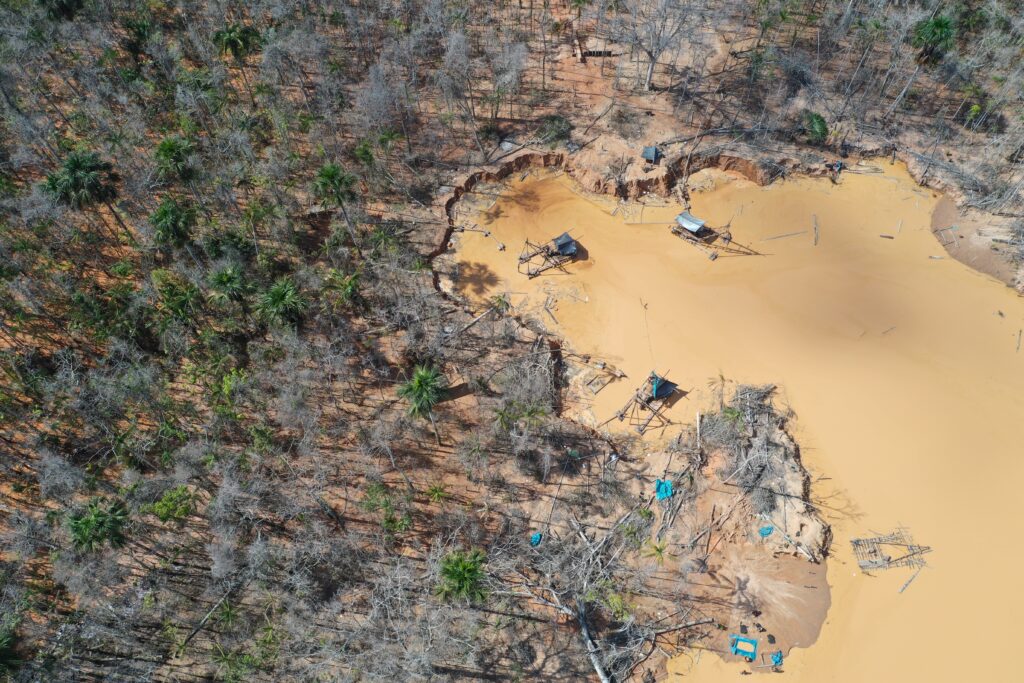
Regulations should establish that all small-scale and artisanal mining activities must be subject to the respective environmental obligations from the initial formalization process, in order to ensure early and effective oversight.
During this process, operations must be subject to governmental oversight by the Environmental Assessment and Oversight Agency (OEFA in Spanish), the Supervising Agency for Investment in Energy and Mining (OSINERGMIN in Spanish), and the National Superintendence of Labor Inspection (SUNAFIL in Spanish). Likewise, administrative and criminal sanctions must be applied to responsible authorities who fail to fulfill their oversight duties.
Additionally, forest zoning should be promoted and advanced, in accordance with the provisions of the Forestry Law (Law No. 29763), with an emphasis on the Amazon regions of Peru. This should be integrated into the mining formalization process and become a formal requirement for granting permits. The integration of zoning will prevent the granting of new permits in priority forests for conservation, reducing deforestation and misuse of forests by directing mining toward areas of lower impact and prohibiting it in critical areas. This would require mining formalization authorities to consult zoning maps from the outset. That is, applicants must include the forest zoning category of their plot and demonstrate compatibility before issuing a permit.
4. Strengthen ASM supervision at the regional level through inter-institutional agreements

We propose the signing of agreements between OEFA and the Amazonian regional governments, accompanied by technical support and technological equipment for real-time monitoring of operations in remote areas.
Furthermore, following the Organisation for Economic Co-operation and Development (OECD) guidelines, the formation of specialized multidisciplinary teams to support field supervision is recommended, helping to close capacity gaps and ensure the effectiveness of environmental monitoring in critical territories.
5. Promote clean technologies and ban the use of mercury by 2030.
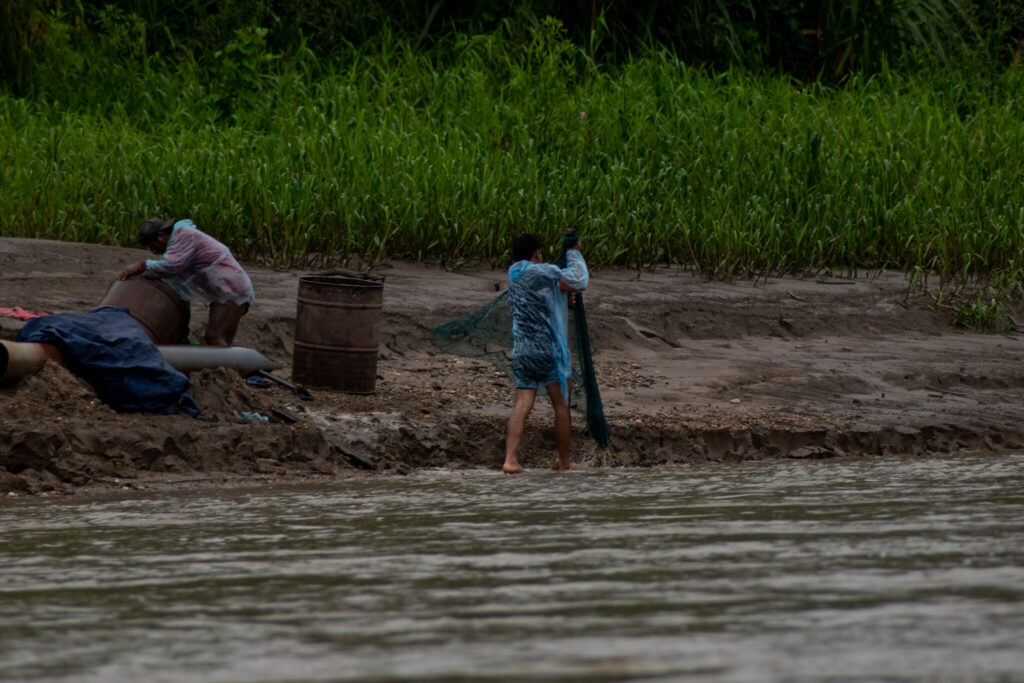
In compliance with the Minamata Convention, Peru must adopt a policy to phase out mercury in gold mining.
To this end, it is recommended that miners be facilitated access to clean technologies through loans, subsidies, or tax benefits, ensuring safer processes for the environment and public health, so that the technological transition increases gold recovery and reduces impacts on rivers and local communities.
However, this policy must be accompanied by specific goals for the protection of forest resources, as well as stricter sanctions for those who continue to use mercury and generate deforestation, thus ensuring true environmental and public health protection. Furthermore, these goals must be expressly incorporated into the Minamata Convention’s National Action Plan, ensuring its effective and coordinated implementation throughout the country.
Methodology
The identification of gold mining deforestation in Peru was based on the visual interpretation of high- and very high-resolution satellite imagery available on Planet, Maxar, and Google Earth Pro for the regions of Amazonas, Cajamarca, Cusco, Huánuco, Loreto, Pasco, Puno, and Ucayali. We conducted a preliminary review of maps and platforms related to mining detection in Peru (the Early Detection and Environmental Monitoring System of the Peruvian Ministry of the Environment, Amazon Mining Watch, and Mapbiomas Perú) to locate potential mining areas. In addition, we compiled reports and newspaper articles related to gold mining in different regions of the country to identify mining areas, as well as direct communications from representatives of different institutions regarding signs of mining activity at the local level. Based on these preliminary processes, we identified gold mining deforestation using satellite imagery. Additionally, we conducted monitoring of mining-related deforestation using monthly Planet NICFI mosaics (4.7 m spatial resolution) to track the expansion of mining-related deforestation and identify new nearby mining areas.
The identification of gold mining deforestation in Madre de Dios used historical mining deforestation information generated by the Amazon Scientific Innovation Center (CINCIA) for the years 1984 – 2019, by Mapbiomas Perú for the year 2020, and by Amazon Conservation (ACA) for the period January 2021 – March 2024. Then, we used the LandTrendR algorithm to identify forest loss in monthly mosaics of Planet NICFI for the period April 2024 – July 2025. Subsequently, we conducted a manual review to identify forest loss resulting from gold mining and other causes.
The identification of river-based mining was based on the visual interpretation of very high-resolution satellite imagery available on Planet, Maxar, and Google Earth Pro for various Amazonian rivers and mining areas in Peru. In addition, confidential reports and direct communications from various institutions regarding the presence of mining infrastructure in Amazonian rivers were included.
References
Arana Cardó, M. (2024). Minería ilegal en la Amazonía peruana: Informe sobre las actividades mineras en las regiones amazónicas de Loreto, San Martín, Amazonas, Ucayali, Madre de Dios y Huánuco. Fundación para la Conservación y el Desarrollo Sostenible Perú (FCDS). https://fcds.org.pe/wpcontent/uploads/2024/07/Resumen_Ejecutivo_informe_mineria_compressed-1.pdf
Conservación Amazónica (ACCA), Proyecto Prevenir – USAID. (2022). Estimación de la población minera informal e ilegal en el departamento de Madre de Dios, a partir del uso de imágenes satelitales sub métricas. https://repositorio.profonanpe.org.pe/handle/20.500.14150/2744
Delfino, E. (20 de julio de 2025). Minería ilegal en Perú: “Hay una presión internacional por el oro y los principales países consumidores no realizan una debida diligencia respecto al origen” | ENTREVISTA. Mongabay. https://es.mongabay.com/2025/07/mineria-ilegal-peru-oro-amazonia-contaminacion/
OCDE (2016). OECD Due Diligence Guidance for Responsible Supply Chains of Minerals from Conflict-Affected and High-Risk Areas: Third Edition. OECD Publishing. https://doi.org/10.1787/9789264252479-en.
Vadillo Vila, J. (2022). La minería ilegal y su impacto en tiempos de pandemia. Diario El Peruano. https://elperuano.pe/noticia/170967-la-mineria-ilegal-hoy
Zapata Perez, M., Arana Cardo, M., Ramires Valle, D., Castro Sánchez-Moreno, M., Garay Tapia, K., Rivadeneyra Tello, G., Vega Ruiz, C. y Cabanillas Vasquez, F. (2025). 10 propuestas para la formalización efectiva de la pequeña minería y minería artesanal. Observatorio de Minería Ilegal. https://www.observatoriomineriailegal.org.pe/wp-content/uploads/2025/05/10_propuestas_ley_MAPE_020525.pdf
Citation
Pacsi R, Novoa S, Yupanqui O, Quispe M, La Torre S, Balbuena H, Huamán B, Valdivia G, Castañeda C, Soria M, Finer M, Santana A (2025) Current situation of gold mining in the Peruvian Amazon. MAAP: 233.
Acknowledgments
This report is part of a series focusing on gold mining in the Peruvian Amazon, through a strategic collaboration between Amazon Conservation and Conservación Amazónica – Peru (ACCA), with support from the Gordon and Betty Moore Foundation.


